INDIA - NEPAL 2015
Out Of Sequence
Overwhelming start to the journey! Yesterday at 7 p.m. Janne called and said that the flight from Arlanda to Zurich had been cancelled. Later, it turns out that Swiss/SAS changed the timetable, which they had notified Janne on 22 June. If he read it? Nope! It’s a good thing he noticed it at all. We still had a ticket from Zurich to Delhi at 12:40 the day after. But how would we get to Zurich? All phone services were closed except Swiss Airlines which referred us to SAS, which was closed! Quick decisions resulted in a booked train ticket to Copenhagen at 11:15 p.m. and a new flight from Copenhagen to Zurich (with only one hour for the transfer). It was now 9:00 p.m. and I wasn’t even home. Hadn’t even packed yet… Anyway… after summoning some unknown superhero powers, we managed to catch the train!
Once in Copenhagen, they claimed that we were ”No Show” and ”Out of sequence”! Was referred to everyone except God (don’t think even he could have solved the bureaucratic problem that we hadn’t left on the flight that didn’t even exist). Looked dim but with 30 minutes to go we chose to try checking in again. And all of a sudden it worked!?!?!
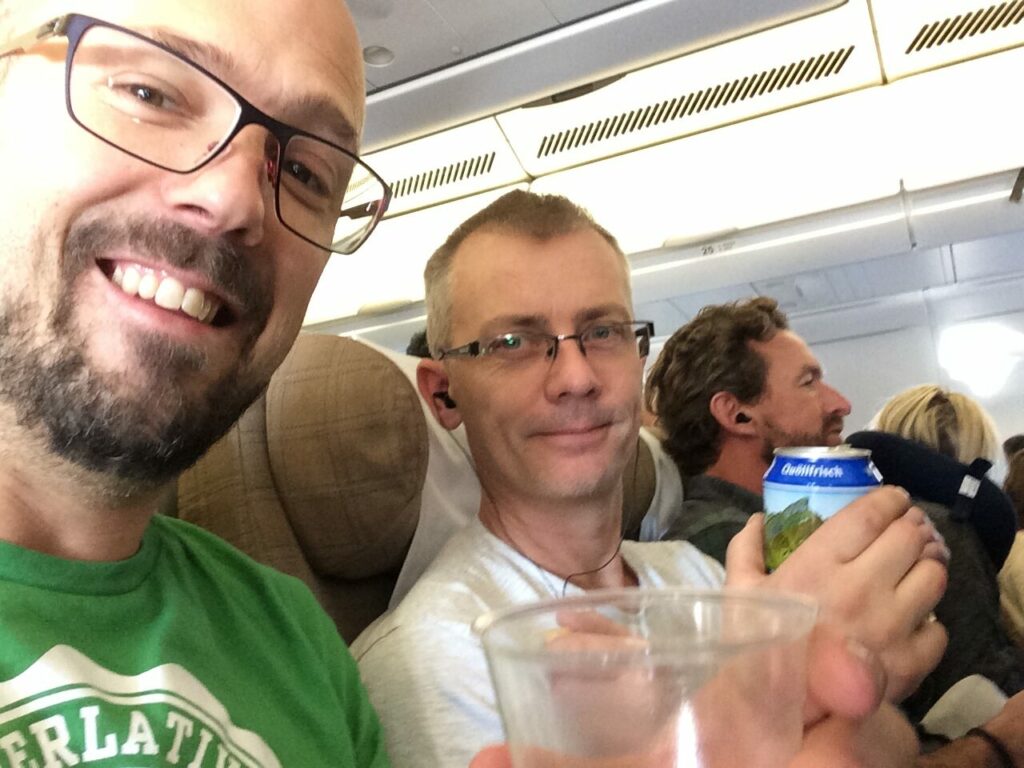
First Impression Nepal
The transfer at Delhi International Airport took some time but was basically hassle-free and now that we had arrived in Kathmandu we were going to fly with the domestic Yeti Airlines to Nepalgunj but we had a four hours gap before departure. Plenty of time for some Kathmandu sightseeing.
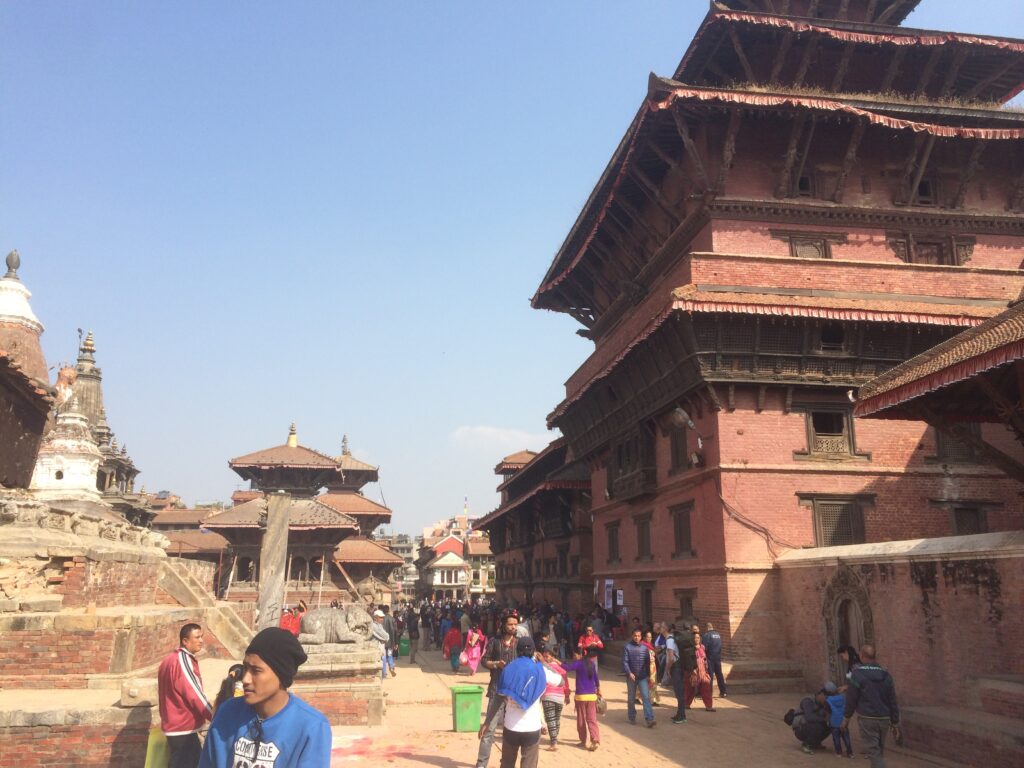
Kathmandu got top marks, here we want to go again! Sure, the city was mostly quite cluttered and mostly not so beautiful. Many of the houses were damaged or cordoned off after the major earthquake that recently struck the area but the city’s vibe was exciting and exotic and the people were very friendly.
The neighborhoods around Pagan Square were also affected by the earthquake but still a nice place for sightseeing. Here we met a super nice Nepalese student who told us about the earthquake and how it was to live in Kathmandu. Of course, we also made time for a couple of beers, which perhaps wasn’t very clever given our gigantic lack of sleep. More on that topic later…
Janne made success with the teddy bears😊

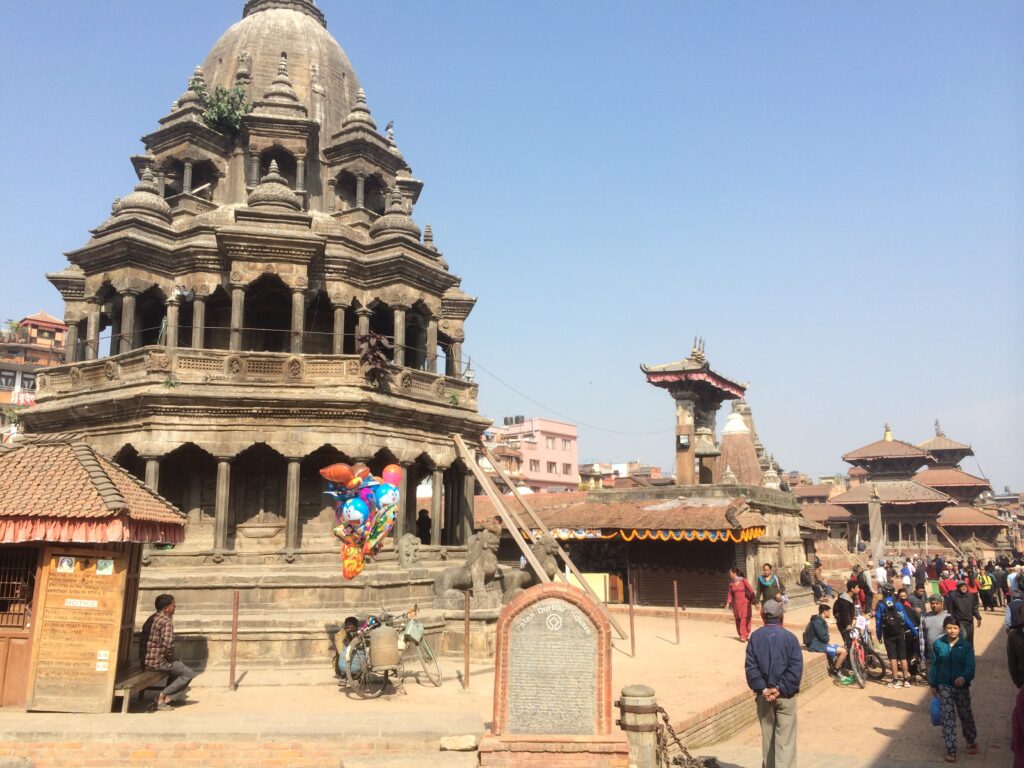
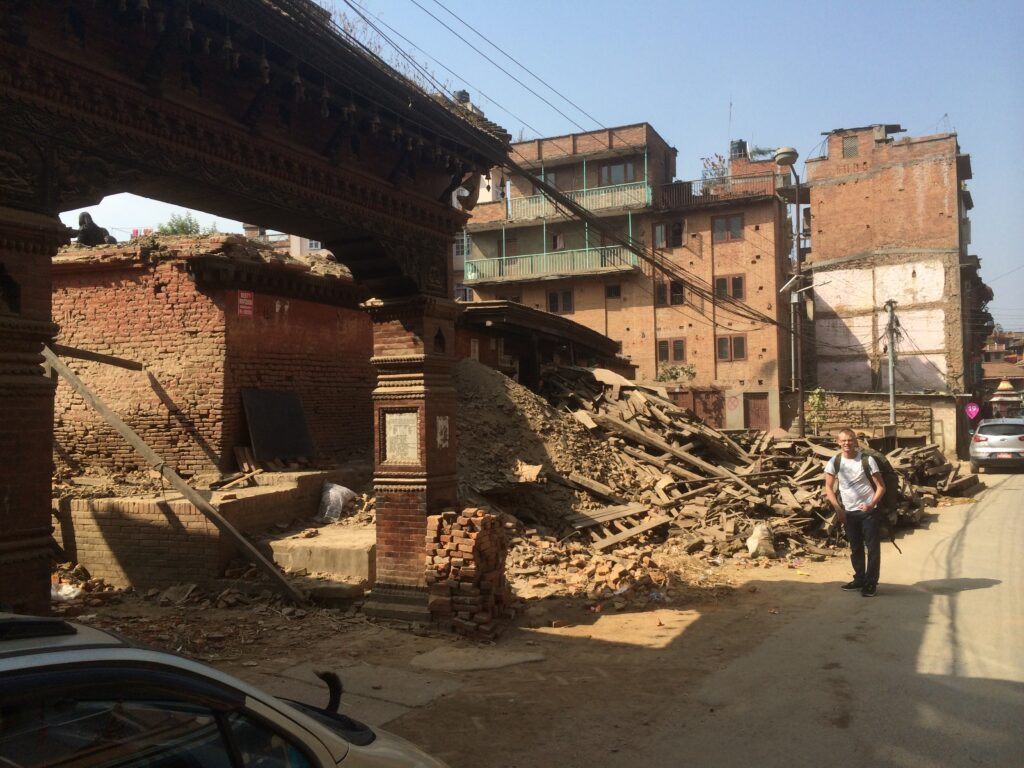
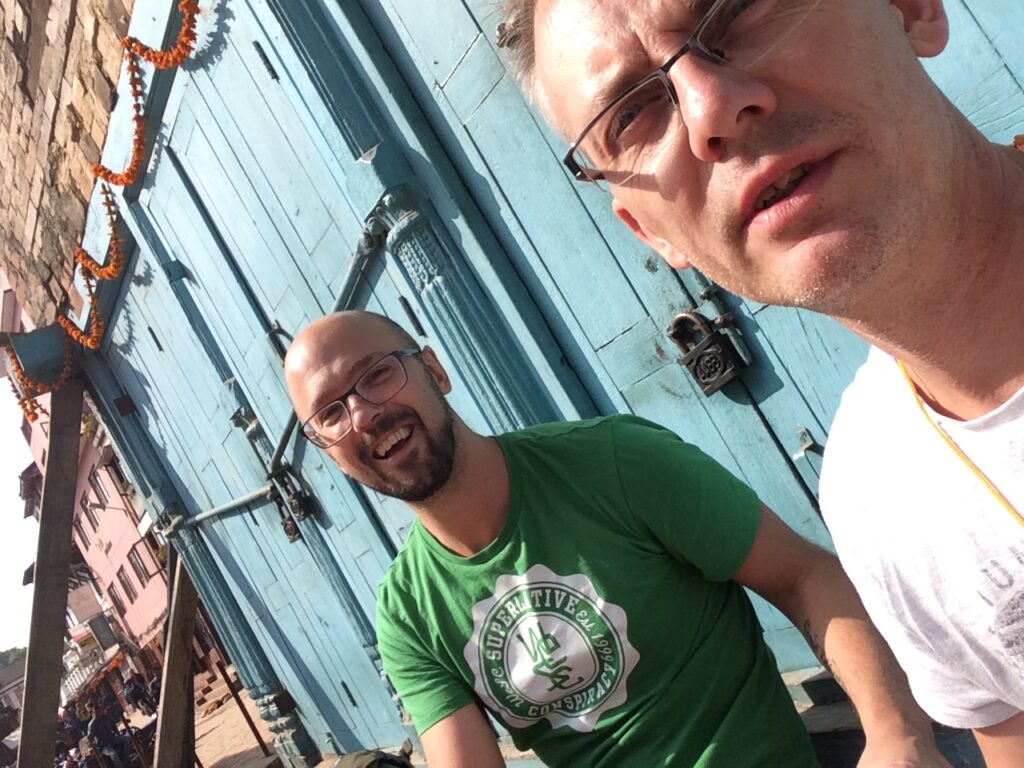
Out Of Fuel
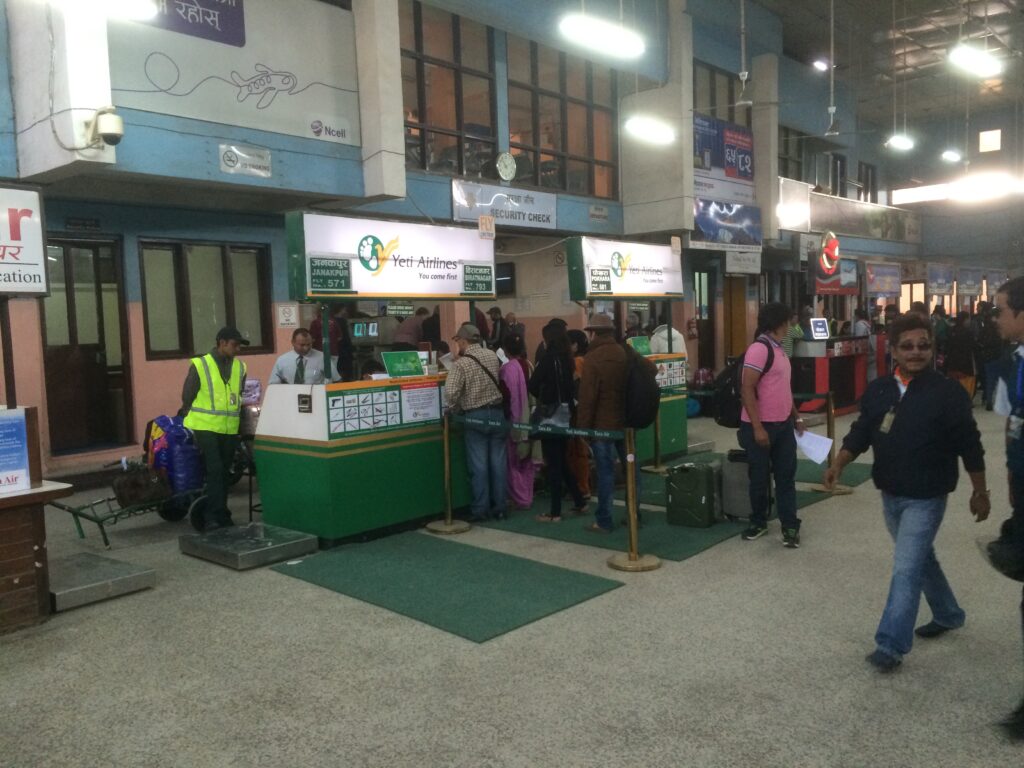
The domestic hall at the airport resembled a bus station (which it probably was) with something that looked like license plates from cars standing on the ticket counter showing the current flight number. After about 30 minutes, the sign with our flight number suddenly disappeared. Apparently, they had found out they didn’t have enough fuel to get to Nepalgunj. It was good that they figured it out before we started flying, but how were we now going to get to there? When we asked around whether there were any buses or if there was an opportunity to hire a driver, we found out that India had imposed an oil embargo on Nepal and that all fuel had been rationed. No one was allowed to refuel more than 15 liters in two weeks so the bus to Nepalgunj was cancelled and no one could get enough fuel to drive us. However, we had to be at the target by 08:00 because we had a booked ticket for a tiger safari and that was the only reason we were going there at all.
After a lot of hassle, we managed to find a guy who could get his hands on fuel from the black market and who, for ”a reasonable” compensation, could drive us. First out of sequence and now out of fuel. Interesting start of the journey…
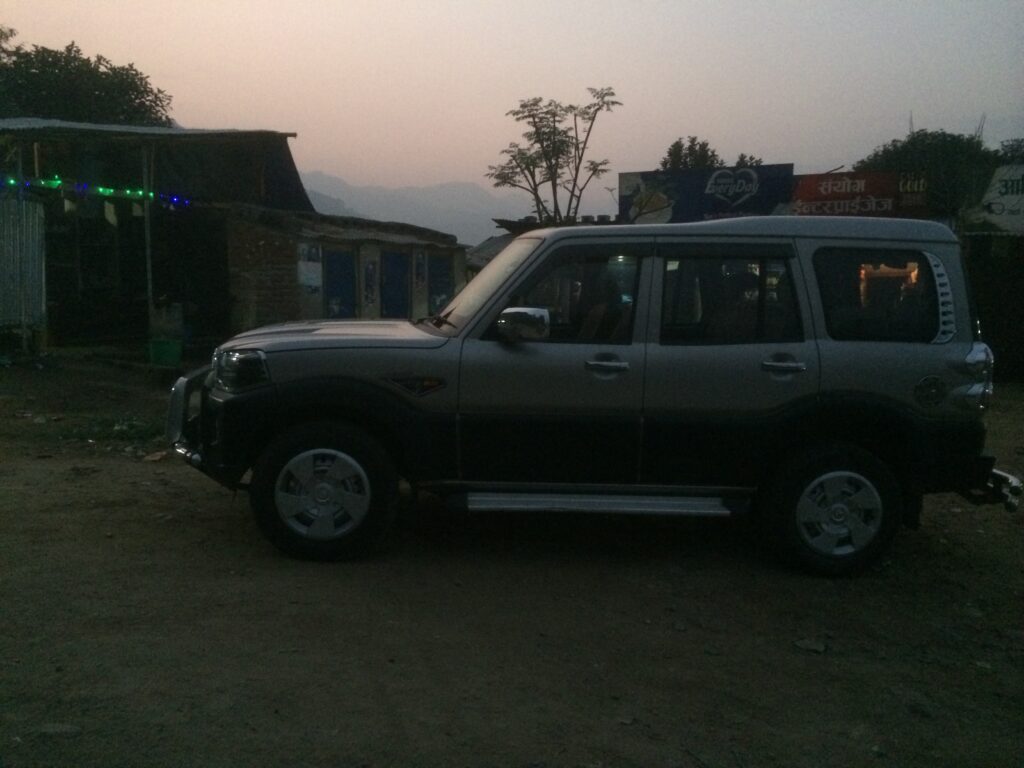

Whether it was the beer we drank in Kathmandu or the lack of sleep (or both) is unclear but Janne suffered the worst motion sickness ever. Pale, cold sweats and nausea in the middle of the night somewhere in Nepal were bad from the start but an urgent need for a toilet did not make things any better. Especially since the driver for at least an hour responded to all the demands to stop with his standard response ”Resting in two minutes”. In the end, it was a shed with primitive toilet that became the rescue. Not nice!
A strange habit that local drivers had was that they didn´t turn off the main beam until they arrived so close to the car in front that they themselves were dazzled in the paintwork.
But to get back to Janne, we (according to the driver) had about 10 hours left to drive on these extremely curvy and bumpy roads before we were due to arrive and then I hadn´t mentioned to Janne that the driver explicit had said that the next 100 km was bad dust roads. Janne didn’t need to know that at the time….
Tiger Safari
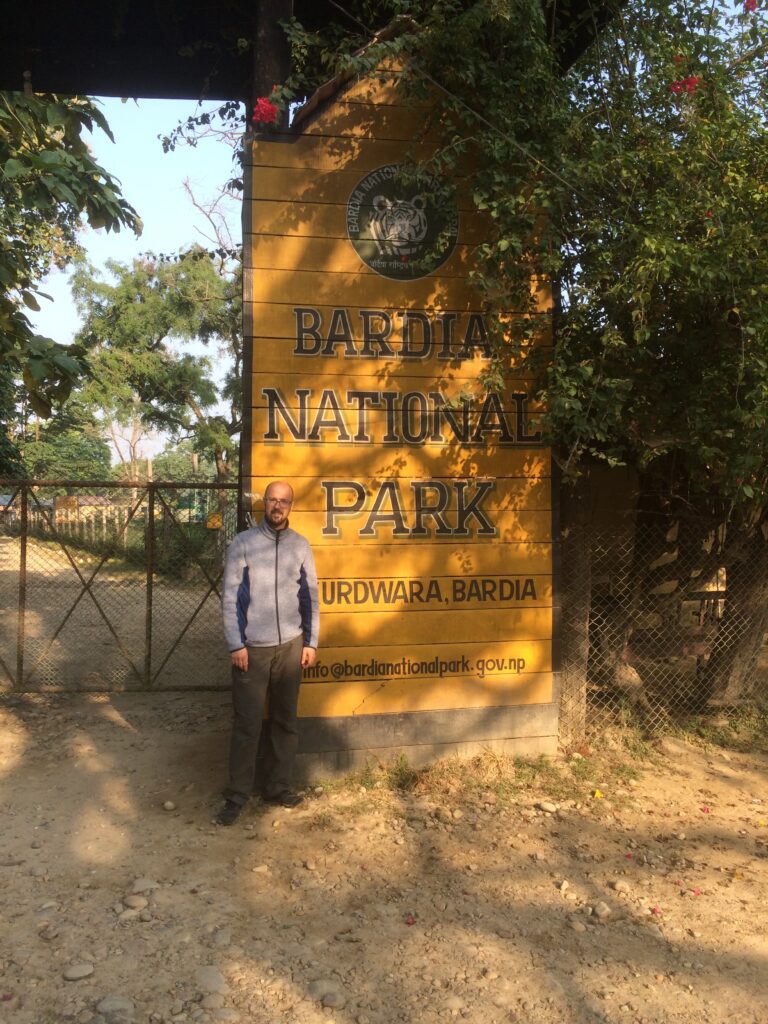
After a long night, we finally reached the national park. I don’t really know what I had in mind, but we didn´t expect to be dropped off at military post and then ride on the back of a military jeep for the last few miles. It turned out that the military was there to stop poachers and the reason we got a ride was that our former driver didn’t have enough fuel. At least that’s how we got it explained… We got to bed at 07:00 and the alarm sounded at 08:00. So consequently… we weren’t the coolest kids in the jungle when the safari started;)
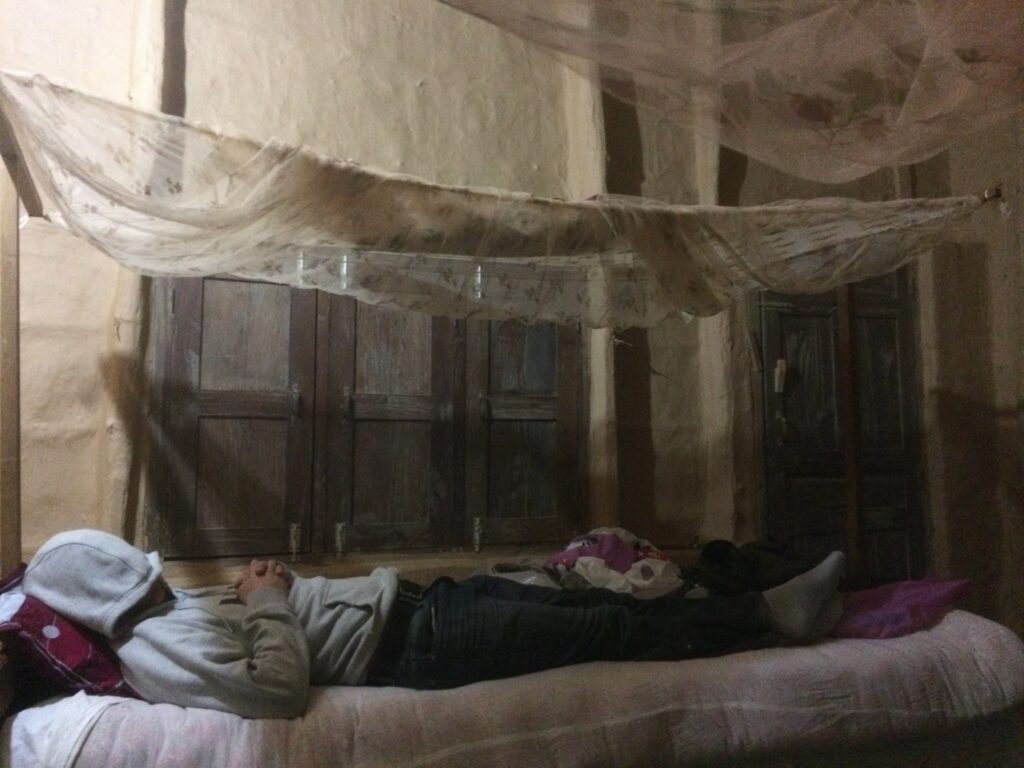
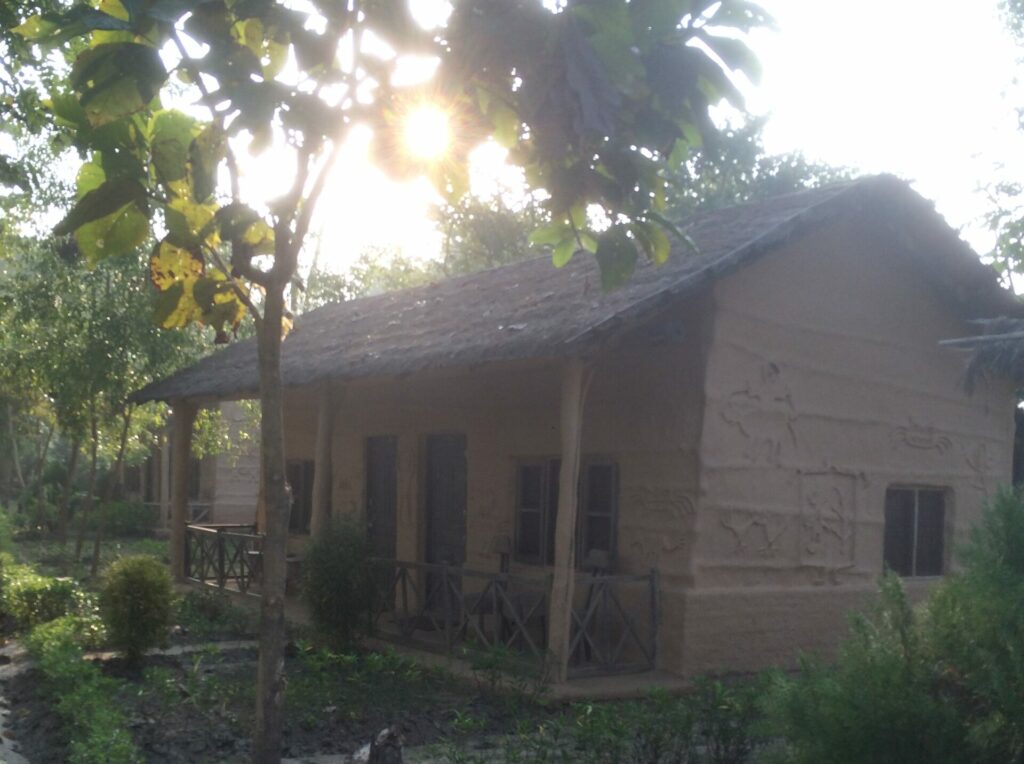
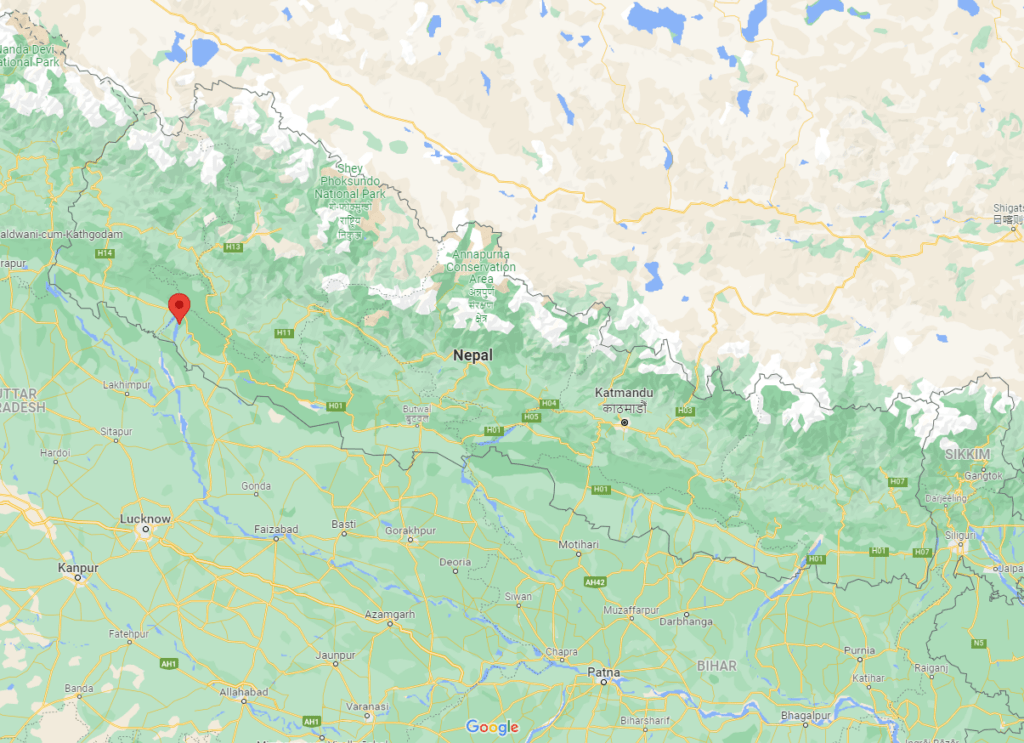
The day started whit a thrilling river crossing.
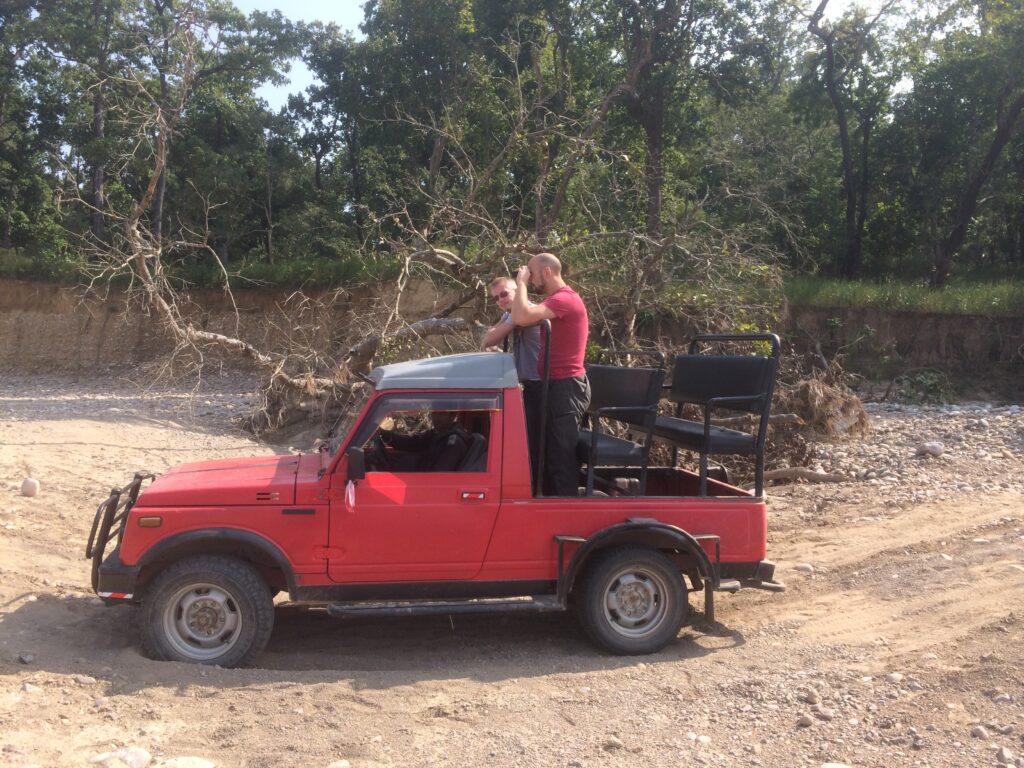
When looking at pictures from safari trips in Africa, there are usually large open savannahs with a clear view in all directions where you can easily see huge amounts of wildlife (and tourists). It wasn’t like that here! Nature consisted mostly of forest/jungle and it was mostly trees and then even more trees you saw. Sure, a lot of monkeys and a few deer were also visible.
We stopped in several different places where, according to the guides, there were good opportunities to see either tiger, rhino or elephant. They also said that some tourists had been travelling around for up to five days without seeing anything but monkeys and deer. To some of their next-time-you-will-see-a-tiger places we had to walk a couple of hundred meters straight into the jungle and although I really wanted to see a tiger, it didn’t feel like a requirement to see one exactly at the time…
According to what we heard from one of the guides, there was also the opportunity to book expeditions where you hiked through the entire national park on foot to look for tigers. It felt good that we didn’t have that kind of ticket…
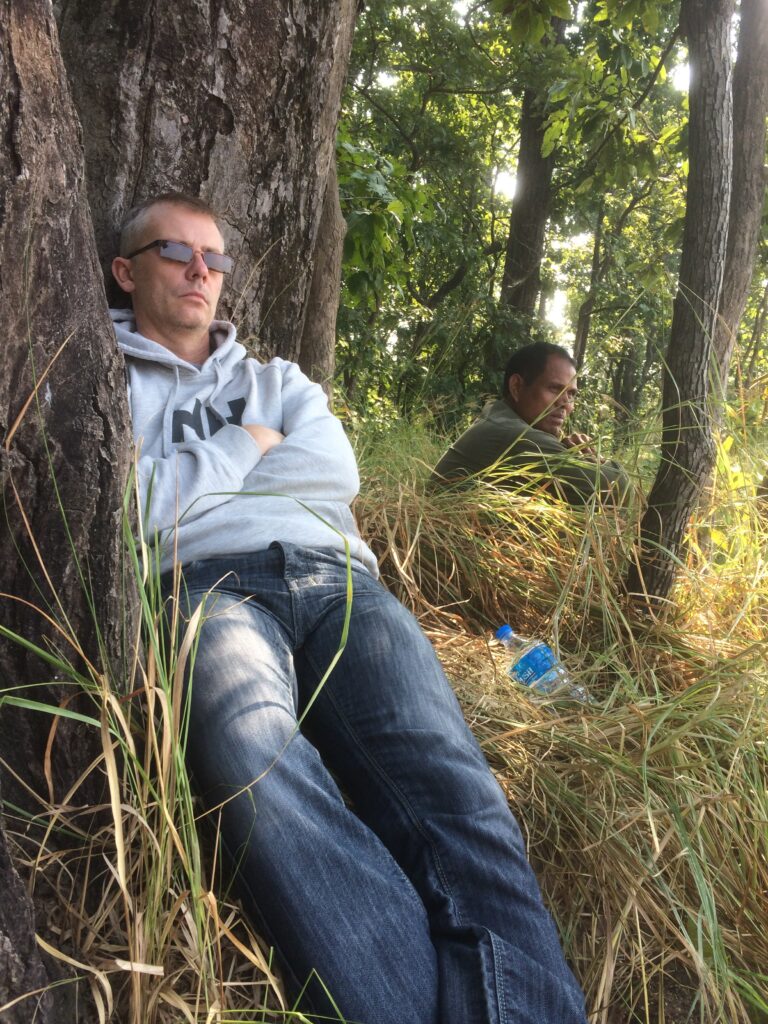

The monkeys were the guides’ assistants. Without them, there wouldn’t have been many tigers to be found… As soon as a monkey sees a tiger they make some outrageous noise and warns everyone against big bad tiger! So when we heard monkey chatter, we stopped and looked for the big beast. Unfortunately, there were 100 other reasons for the monkeys to make noise…
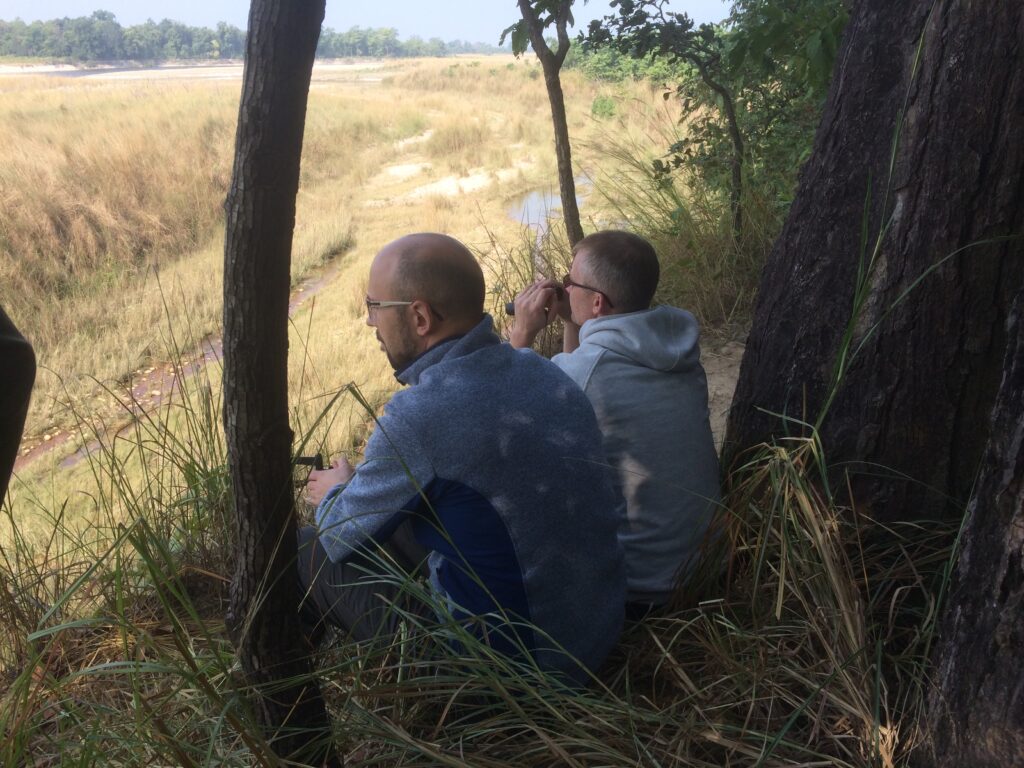
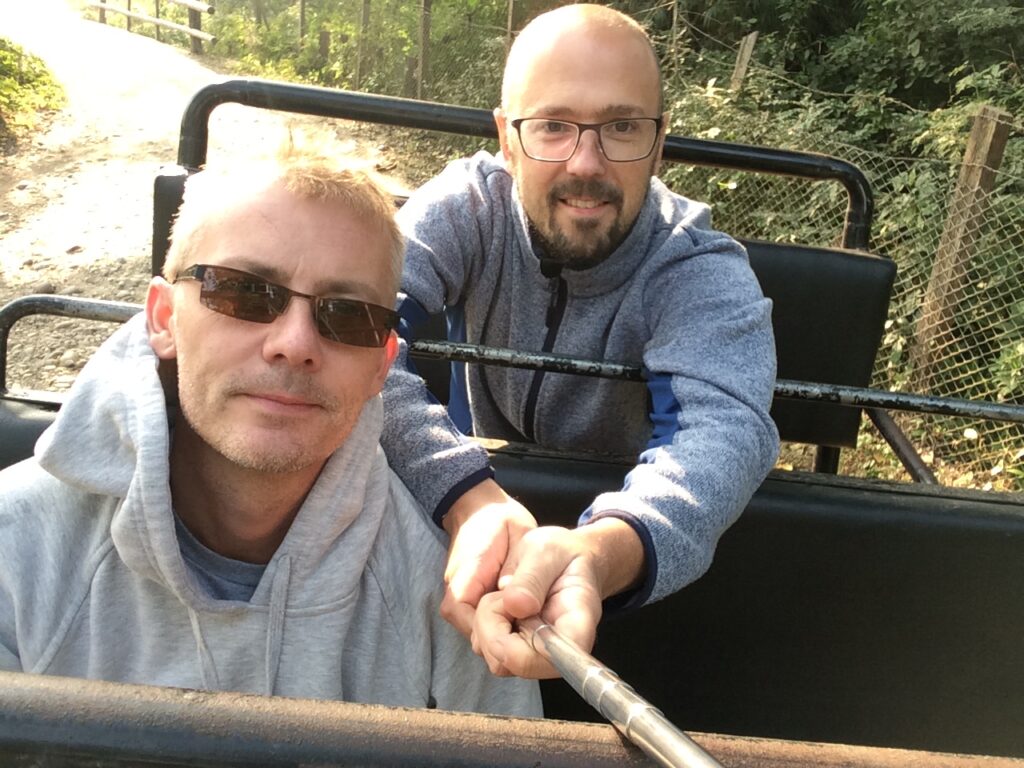
After a number of hours without a glimpse of any tiger (no humans either for that matter) we began to despair. But! Then it happened! A tiger! All of a sudden everything was as it should be again:) It’s a magical experience to see a tiger up close. The guides didn’t even have weapons to defend themselves with, just an old wooden pole. As if it that had been helpful if the tiger had been hungry for two Swedes.

The tiger came sloping along the road as if it owned the whole jungle (guess it did) and although it appeared to be on its way to the car, our driver jumped out and lay down on the ground to take pictures…

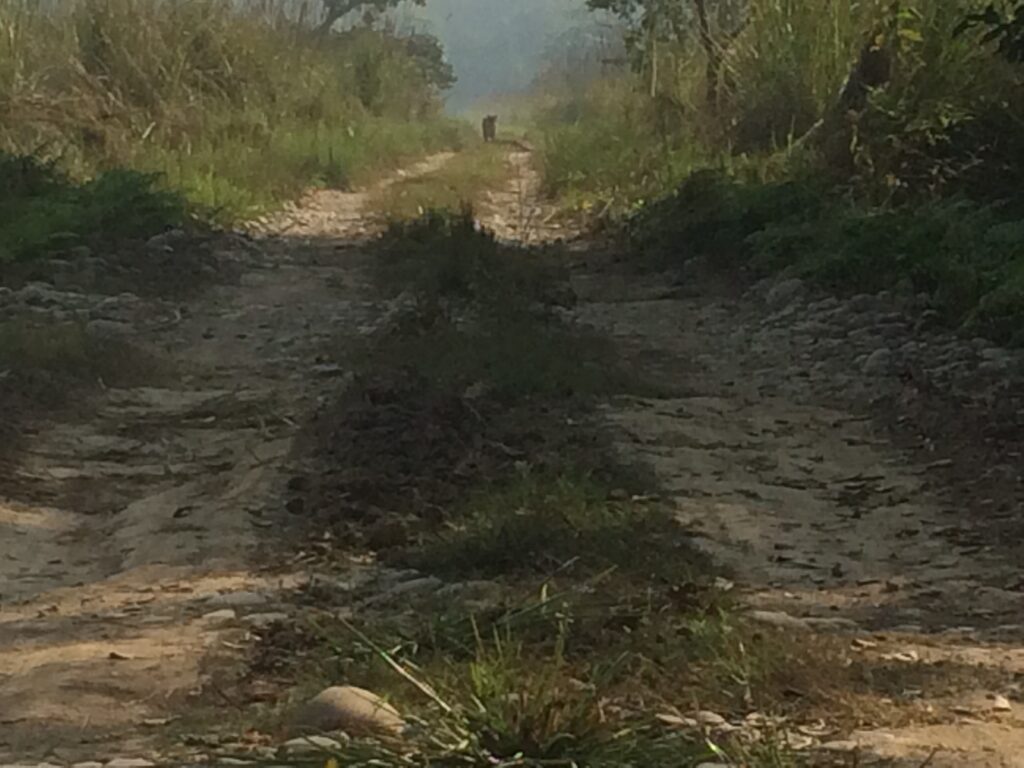
Now that we had seen a tiger, we also wanted to see a rhino:) We didn’t have much time left before it would start to be dark but the guide thought we might be lucky.
That didn’t happen…
But we saw both rhino tracks and rhino poo. Does that count as close enough?
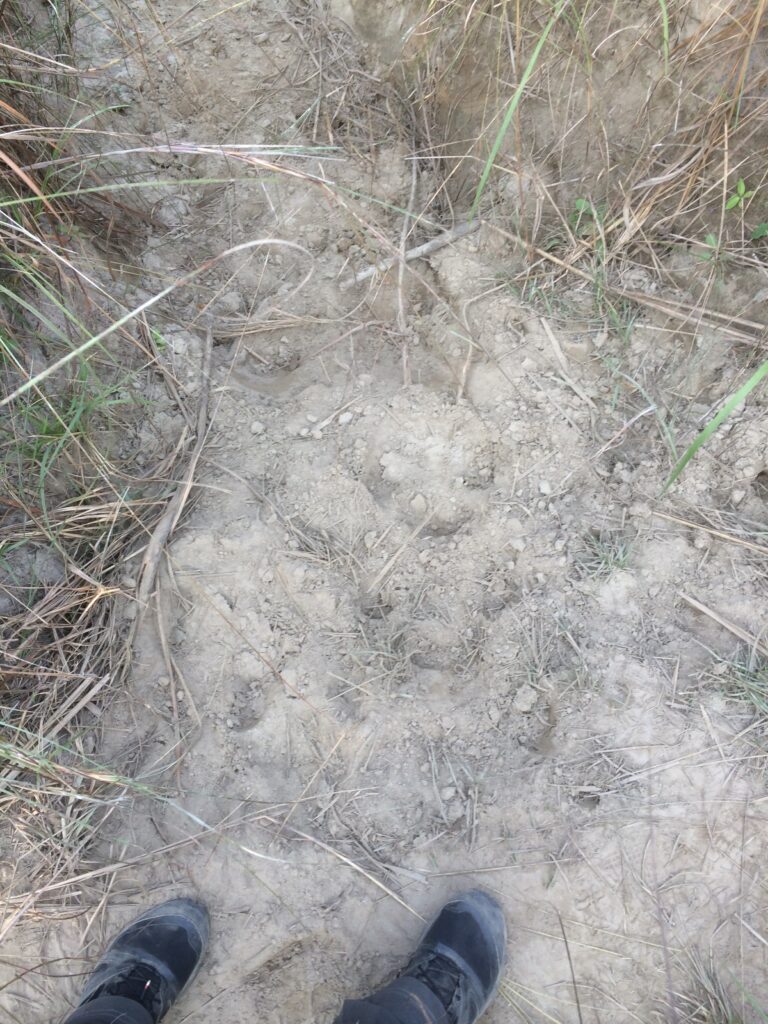
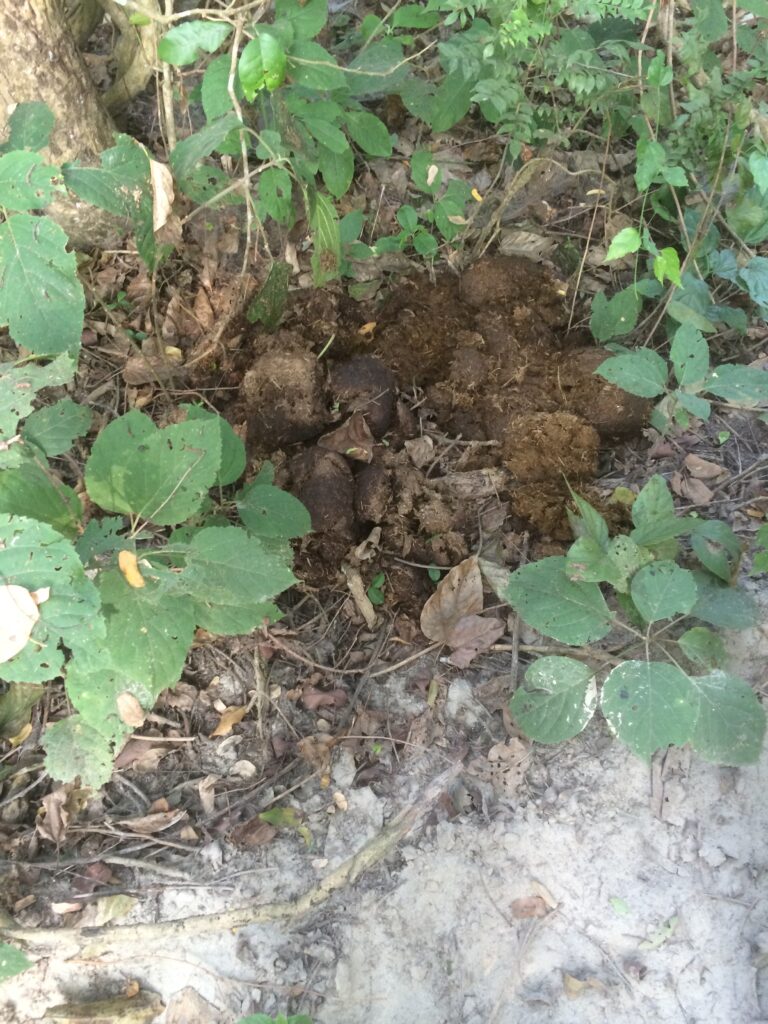
We were quite tired when we got back to the lodge so the food and beer were a real reward after a long day. Later in the evening we heard the sound of drums and singing from the jungle. Apparently, there were some smaller houses around the lodge and there was still New Year celebrations going on. We were invited to participate in the dance and at least Janne did a decent job. It attracted applause and laughter when he tried to teach them the Swedish dance polka.
The villagers also told us that there had been a black leopard down in the village (at our hotel) the other night…
On our way to Nepal and the border with India, we crossed several rivers with lots of crocodiles. Didn’t even know there were crocodiles in Nepal so it was a good thing the swim trunks were packed at the bottom of the backpack…
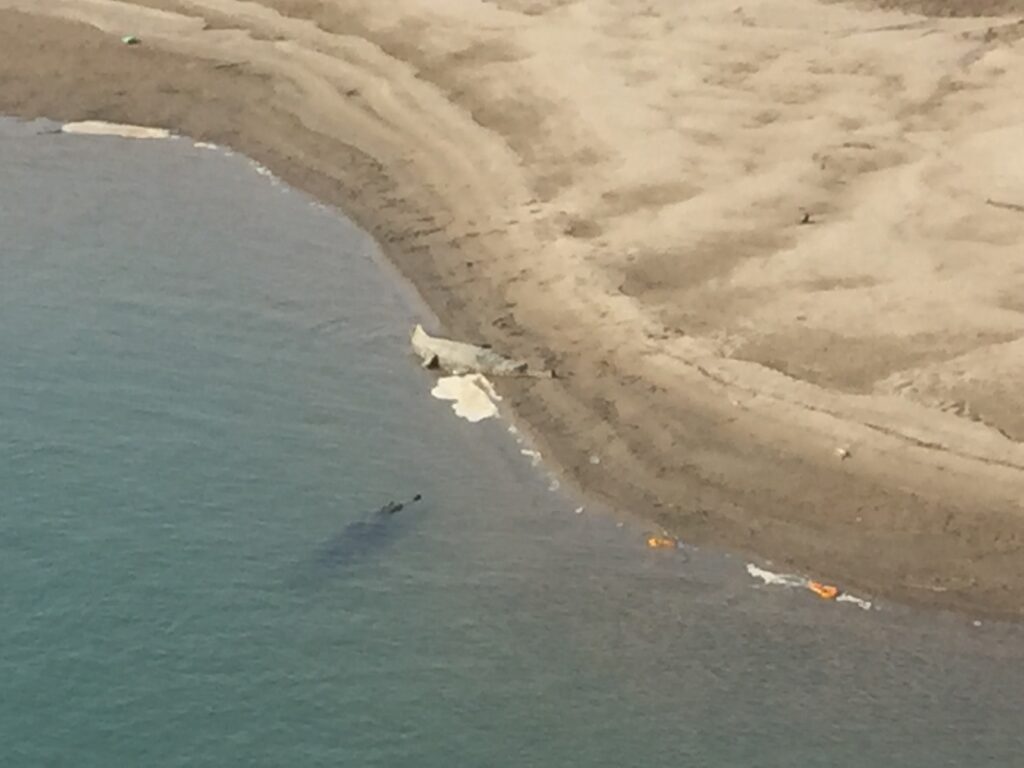
Don´t Forget The Stamp!

When we were dropped off a couple of 100 meters from the Indian border, our driver pointed out the importance of that all the papers had to be in order and then he pointed to the border. We were admitted to an office where a man in a military uniform asked for our passports and then he quickly established that something was missing. Apparently, a stamp was needed showing that we had gone out of Nepal and such a stamp was nowhere to find in our passports or in his office. So, it was just to walk to another office building a couple of 100 meters from the border.
Once there, the new official replied: ”Yes, I have stamps. But you don’t need stamps and I won’t give you any stamps.” At least that’s what we thought he said because he didn’t speak English. After walking back to the border and informing the military man that we didn’t need any stamps (at least no one who wasn’t already in the passports) we were again refused entry because according to the military man there should be a stamp and if anyone else had said otherwise it was wrong… We were again referred to the man with the stamps and this time he almost gave in but with the stamp in his hand he changed his mind at the last second…
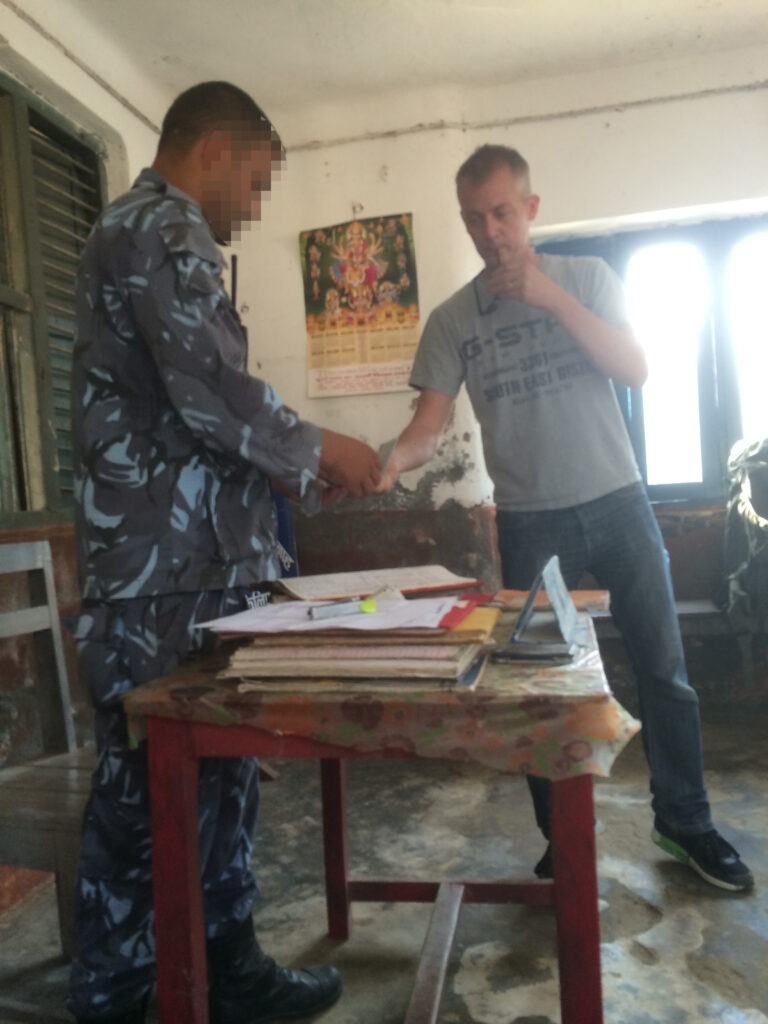
Unclear how many times we had to go back and forth but in the end we were let through without this mysterious stamp. But we got one: ”You´ll blame yourselve” as a final farewell.
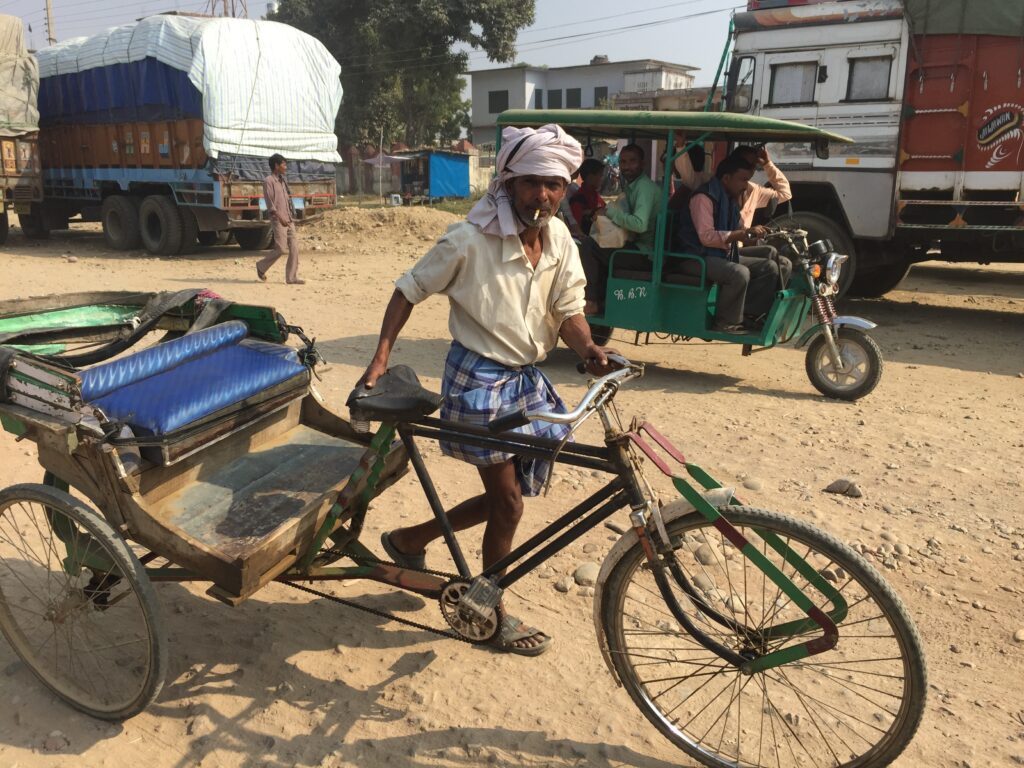
We got maybe 25 meters into India before we were grabbed by a woman who dragged us into an office. On the positive side, the official in the office spoke English and the negative was that we under no circumstances could be allowed to enter India without having a stamp proving that we had travelled out of Nepal.
Started to get pretty tiring….
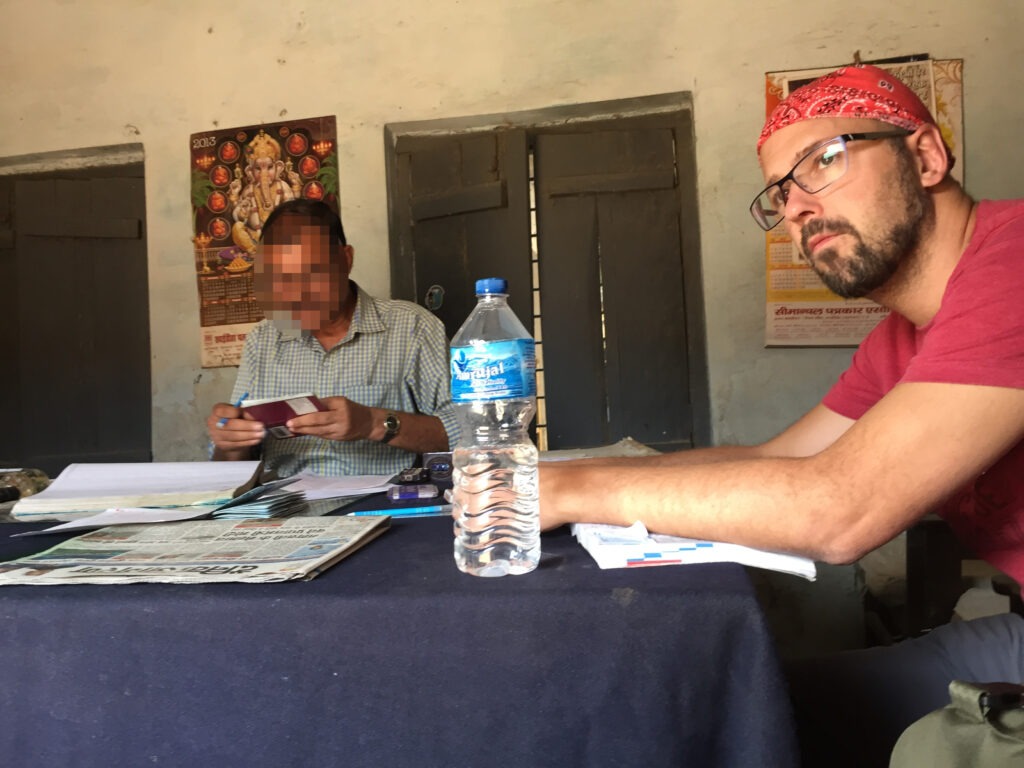
After many phone calls and accompanying wait, we were again referred back to the stamp man on the Nepalese side. Now, however, the calls from the Indian official had made things happen and the stamp man pointed to a door 10 meters further away and inside was a stamp woman. A person who actually could give us the long-awaited stamp.
It later came to our attention that the stamp man worked as a customs officer and that he only stamped out goods…
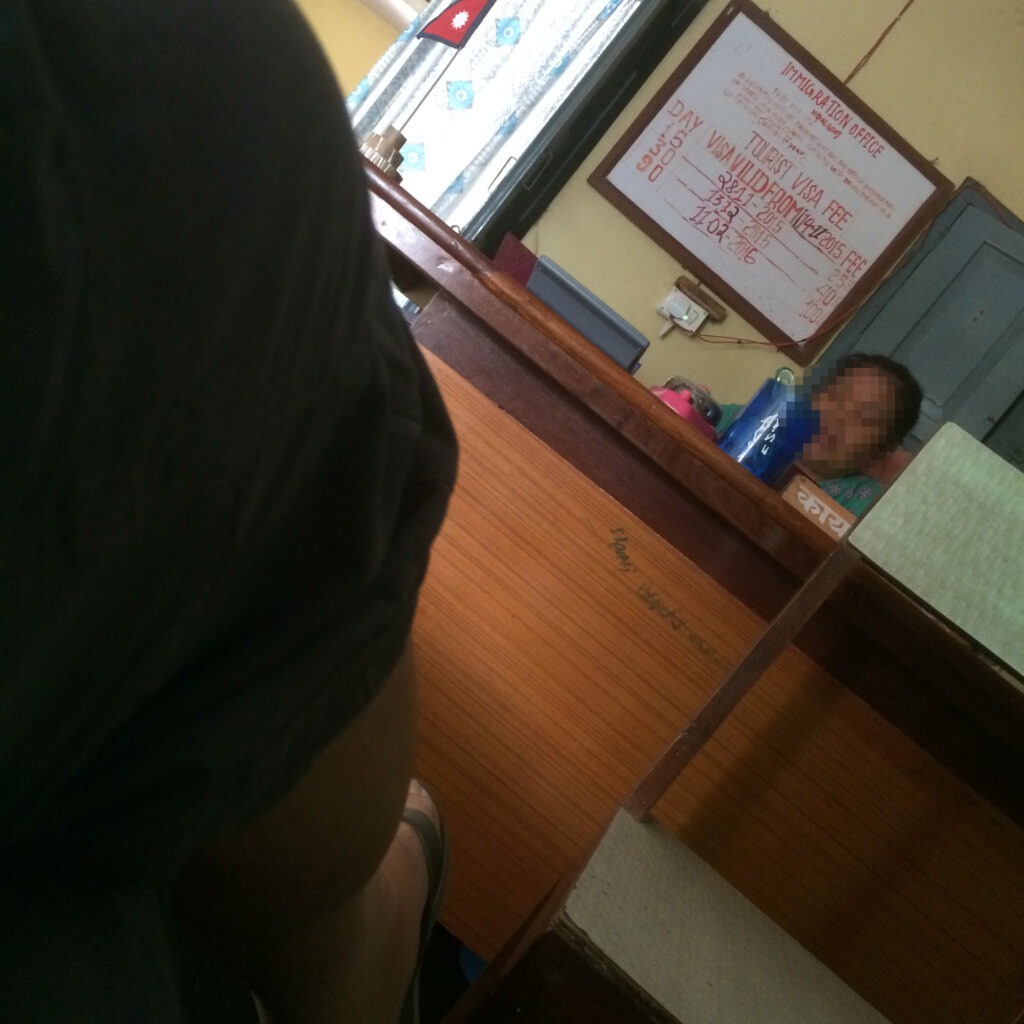
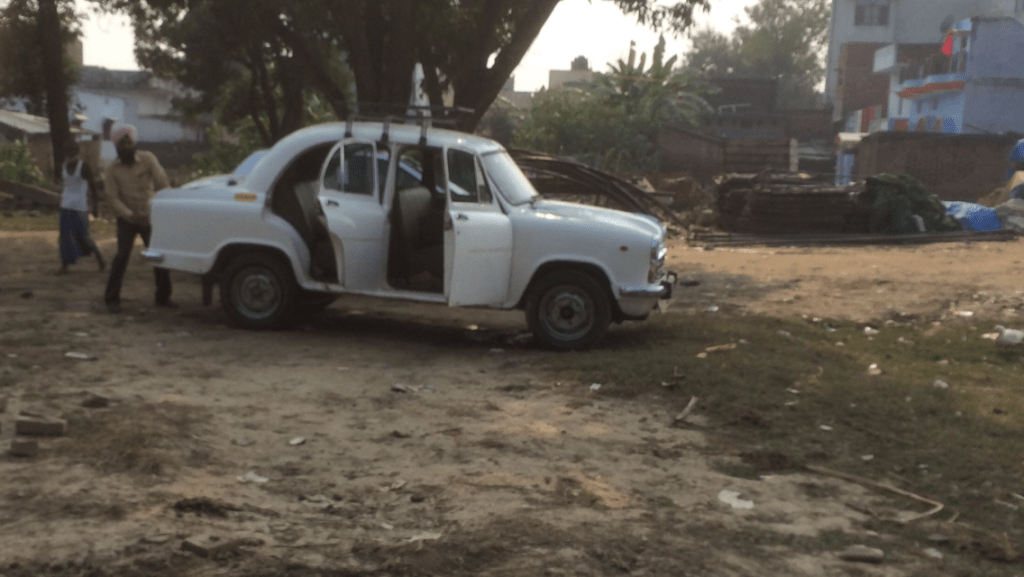
Then all we had to do was to find a taxi and get a ride for about 200 km to the town Gonda where we were hoping to catch a train to Varanasi. There were plenty of taxi drivers and the cars looked decent until we saw that it was the car behind all the other cars we were going to ride with… A classic Hindustan Ambassador!
Once in Gonda it turned out that there were no trains to Varanasi and we didn´t want to get stuck in Gonda for several days so we had to find a taxi for the remaining 280 km to Varanasi. However, it proved to be more difficult than expected to find someone who would consider driving to Varanasi for a reasonable amount of cash. In the end we managed to make a deal with two younger guys (at least they looked old enough to have a driver’s license) but when we saw the car we almost started to regret the deal…
Already after the first block, they were about to collide with a bus and then it just got worse. It´s not possible to describe the feeling of near death that we experienced throughout the 7-8 hour journey to Varanasi. It was scary when the driver opened the door and vomited while he still was driving. And that was far from the worst incident, but we survived:)
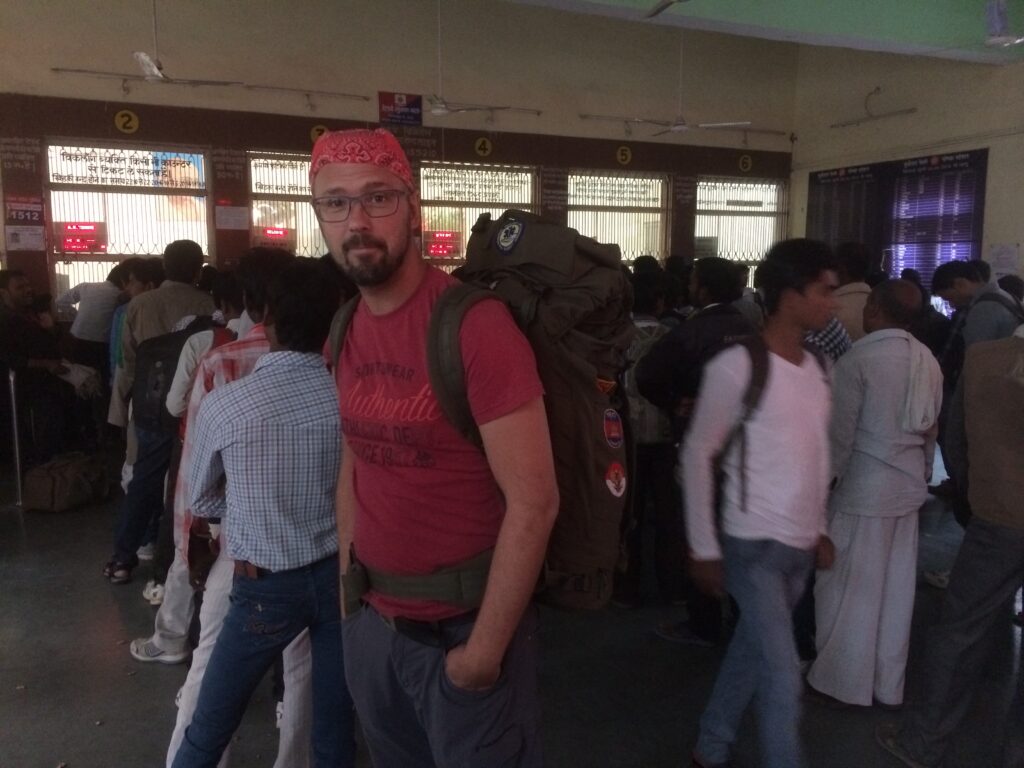

The taxi driver dropped us off in the middle of the metropolitan traffic at the railway station in Varanasi. For sure the traffic both in Vietnam and Cambodia had been crazy, but here it was truly world class…
The Holy City At Gagnes

Varanasi was a melting pot of different religious orientations and for both Hindus and Buddhists the city is an important pilgrimage site. There was no mistaking the city was sacred. It was a kaleidoscope of people of different clothing, temples and other religious buildings, as well as unprecedented private and public rites. Add the background cacophony consisting of immense traffic, an eternal honking, unusual smells and all the cows, it’s probably easy to understand that it was an intense adventure.
For Hindus, Gagnes is sacred, purifying themselves in the river at the city’s ghats as well as being cremated by the river at the end of life and then having the ashes submerged in the water are important parts of their religion. For the Buddhists, it was at the Sarnath Temple that Buddha gave his first teaching after attaining enlightenment.
Although we had read a lot before we arrived and that we were on some guided tours, it was beyond our ability to understand everything that was happening around us but it was really an eye-opener to see how everyone, Hindus, Buddhists and Muslims lived side by side. Whether it was trouble-free is unclear, but seeing all these people with their different customs and rituals still provided a seed for increased tolerance and understanding that people are different.
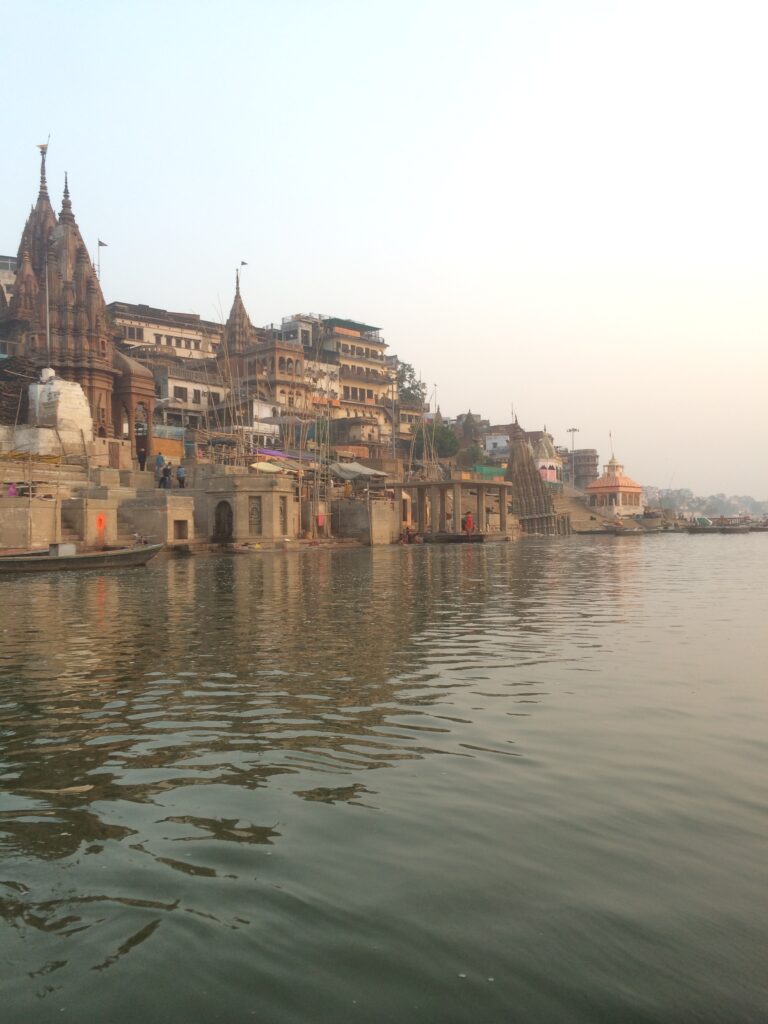
One evening we booked a guided boat tour. It was a great way to get an overview of all the ghats and cremation sites. Although not all of the guides stories maybe wasn´t 100 percent true, we found out a lot that wasn’t in the guidebooks.
The bonfires used for cremation burned almost 24/7 and then the ashes were sent into the river. This can be good to know if you intend to stay in one of the cheaper riverside hotels. They wash their laundry in Gagnes….

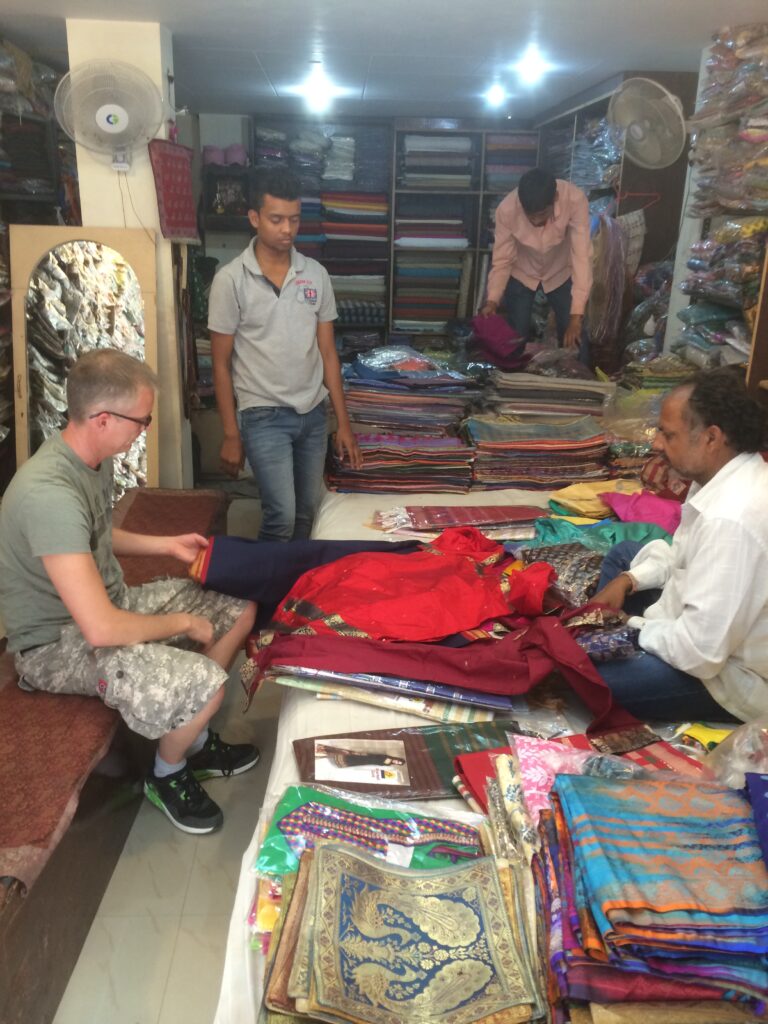
Varanasi is also known for its fabrics so a bedspread felt like a reasonable souvenir. Although I am not the right person to comment on the quality and fashionability of the fabrics, I thought the fabrics were nice. Unfortunately, the manufacturer was better at haggling than me. We also were invited to visit the factory and we can sum it up by saying that I wouldn´t want to be a union safety representative there.
Never has a Kingfisher tasted better than it did at the hotel pool after a full day walking through Varanasi’s alleys!
Did we like Varanasi? Can we recommend going there? The last question is easiest to answer. Yes, because it takes a novel to describe the city, you have to come here yourself. Did we like it? Not all the time… and yet I think we both could agree to come here again. Varanasi is like a psychosis and you probably would need a local who can lead you through the chaos and at the same time give a glimpse of everyday life.
Anyway, it was lucky that we booked a nice hotel with bar and pool because I had, a little naïvely, expected the alleys in Varanasi to be crawling with bars and small restaurants.
That’s not how India’s most religious city works!
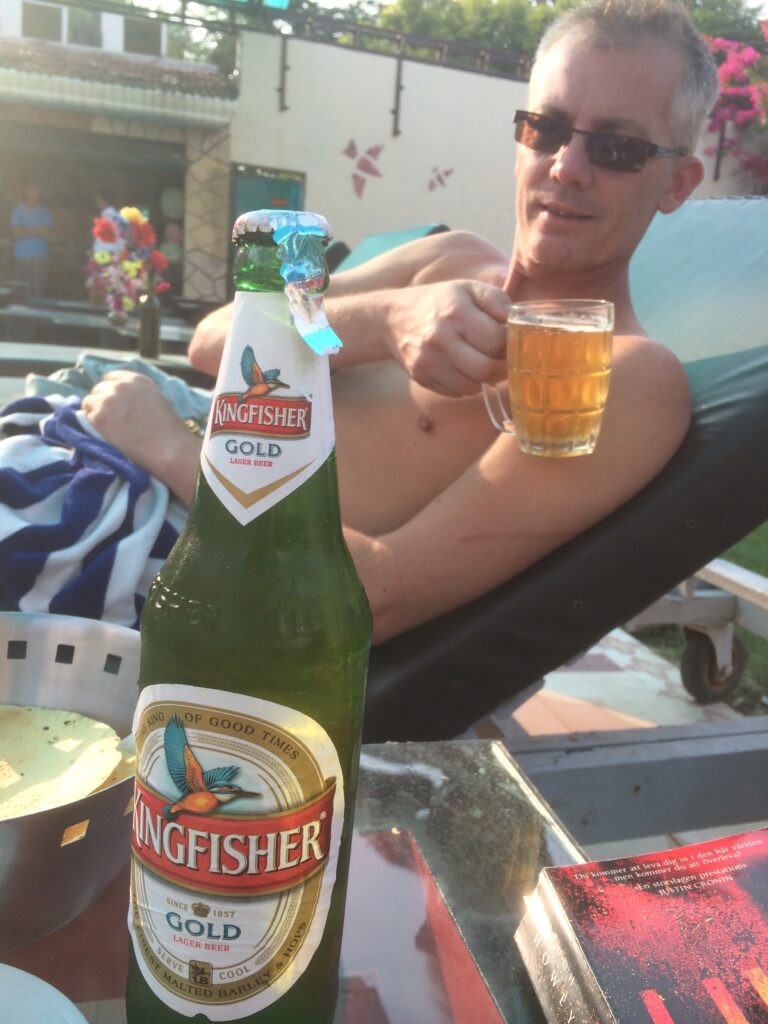
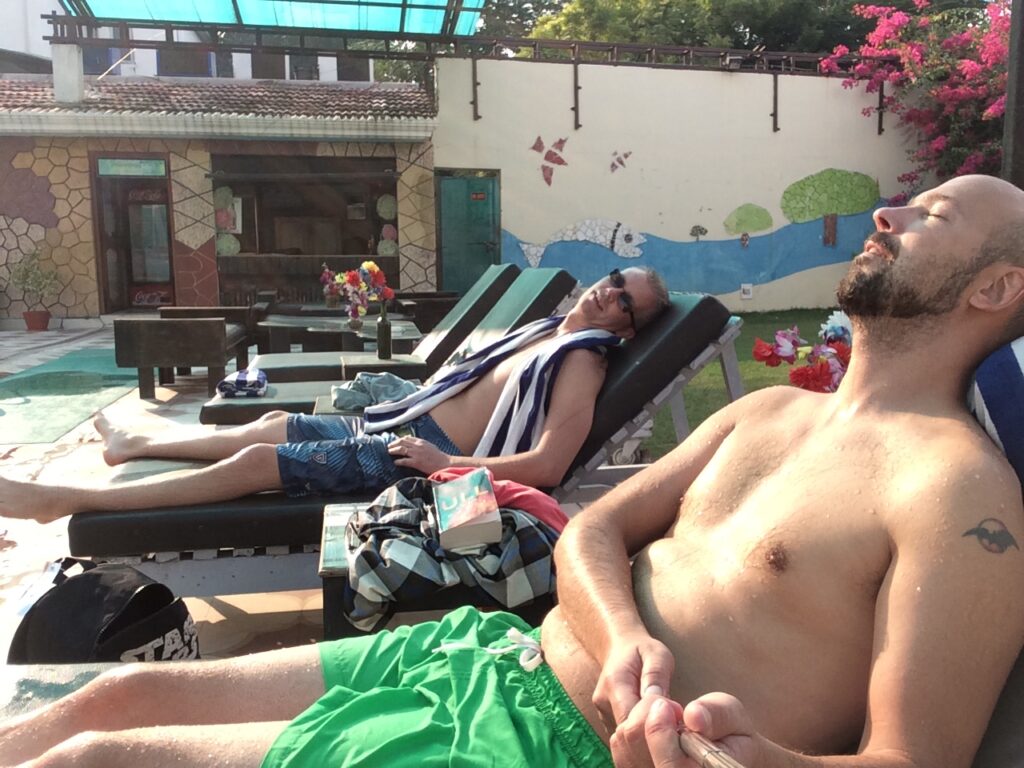
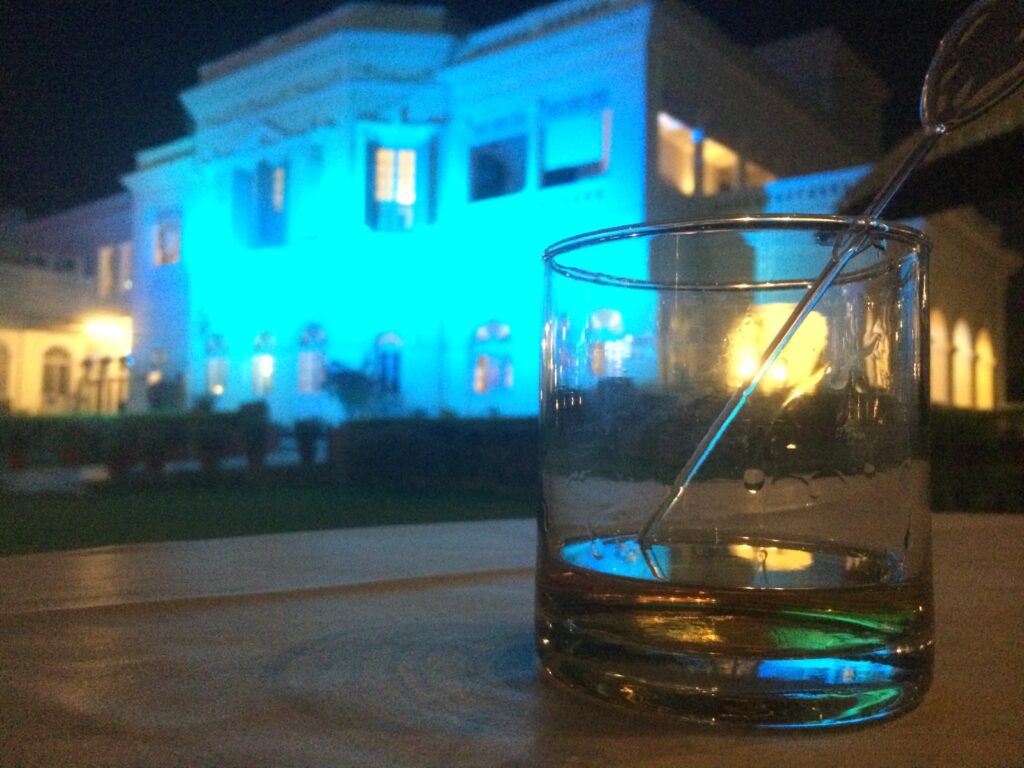
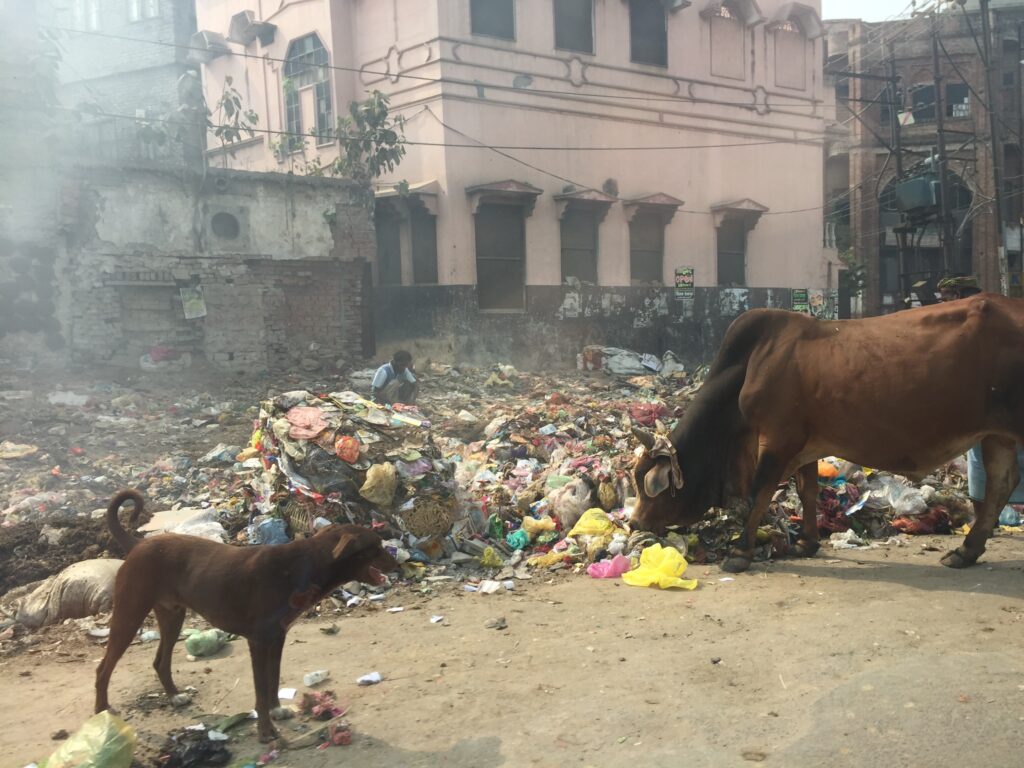
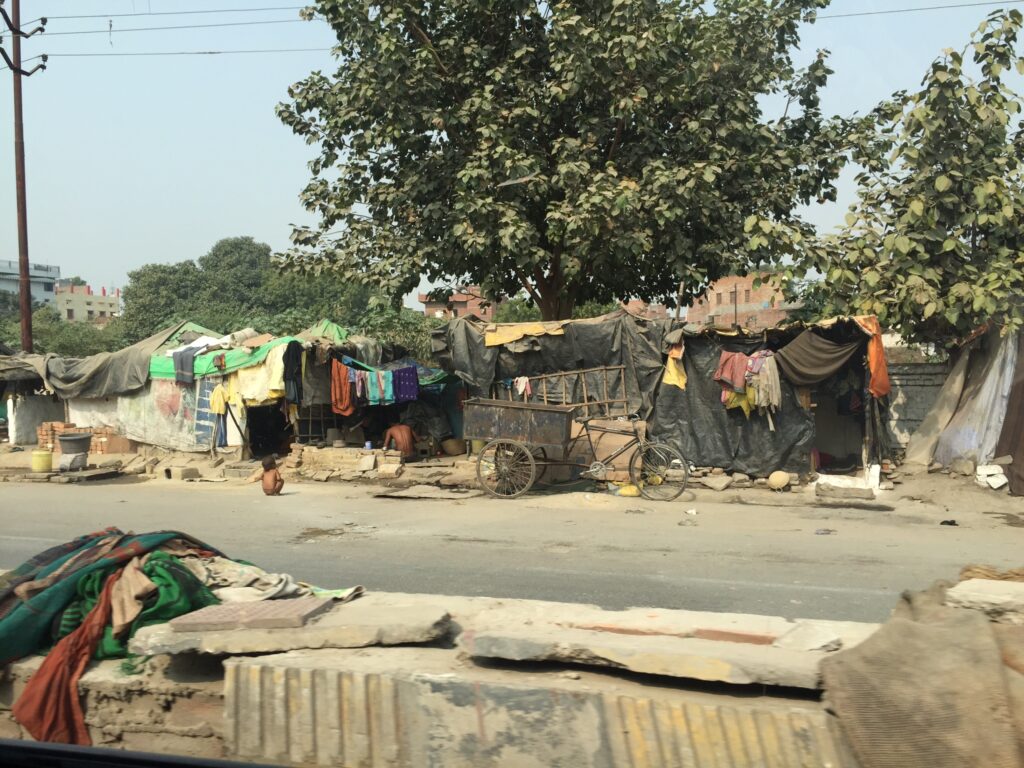
Many of the experiences that stuck in the memory were the cultural clashes that highlighted how privileged we Westerner in many ways are. At least economically and materially. It is possible that you perceive that we portray our experiences based on an elitist view of life and that we only complain about others’ way of life. Behind everything that we perceived as strange and peculiar and that we may have laughed or been horrified by, there has always been a human being with a warm smile.
But it´s not possible to describe India without mentioning the incredible socioeconomic gaps that exist in the society. Between two houses with decent cars parked outside, people lived in literal piles of rubbish. Of course, as usually is the case at more trendy destinations, they could have cleaned up the misery so that we tourists didn´t have to see it, but at the same time this is what it looks like in many parts of the world and it´s part of the unpolished surface that a traveler in India must and should take part in.
From wikipedia (Sarnath):
”Also referred to as Isipatana, this city is mentioned by the Buddha as one of the four places of pilgrimage his devout followers should visit. It was also the site of the Buddha’s Dhammacakkappavattana Sutta, which was his first sermon after attaining enlightenment, in which he explained the four noble truths and the teachings associated with them.
Sarnath has been developed as a place of pilgrimage, both for Buddhists from India and abroad.
In Buddhism, the Four Noble Truths (Sanskrit: catvāri āryasatyāni; Pali: cattāri ariyasaccāni; ”The four Arya satyas”) are ”the truths of the Noble Ones”, the truths or realities for the ”spiritually worthy ones”.’
The truths are:
- dukkha (suffering, incapable of satisfying, painful) is an innate characteristic of existence in the realm of samsara;
- samudaya(origin, arising) of this dukkha, which arises or ”comes together” with taṇhā (”craving, desire or attachment”);
- nirodha(cessation, ending) of this dukkha can be attained by the renouncement or letting go of this taṇhā;
- magga(path, Noble Eightfold Path) is the path leading to renouncement of tanha and cessation of dukkha.
They are traditionally identified as the first teaching given by the Buddha, and considered one of the most important teachings in Buddhism.”

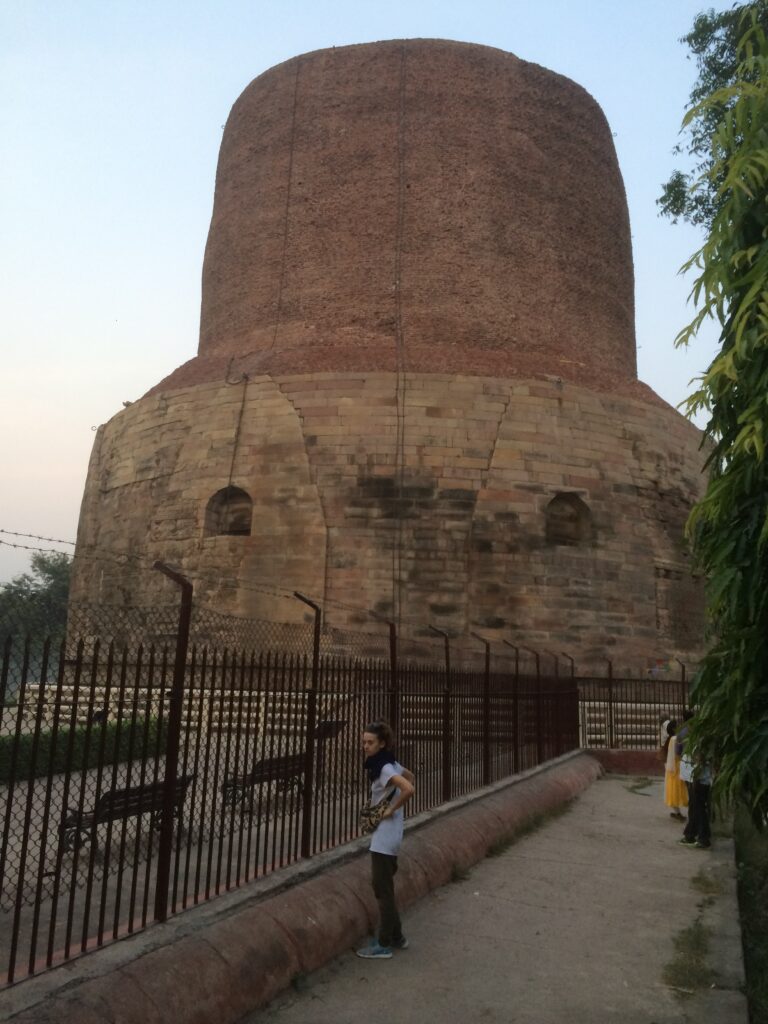
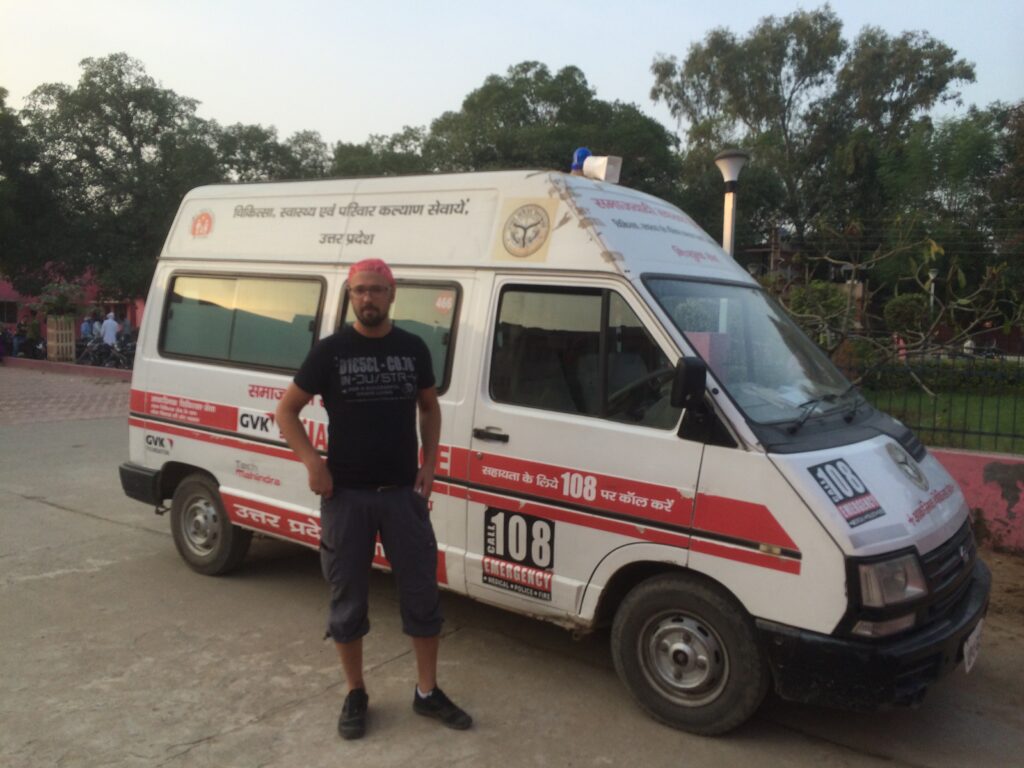
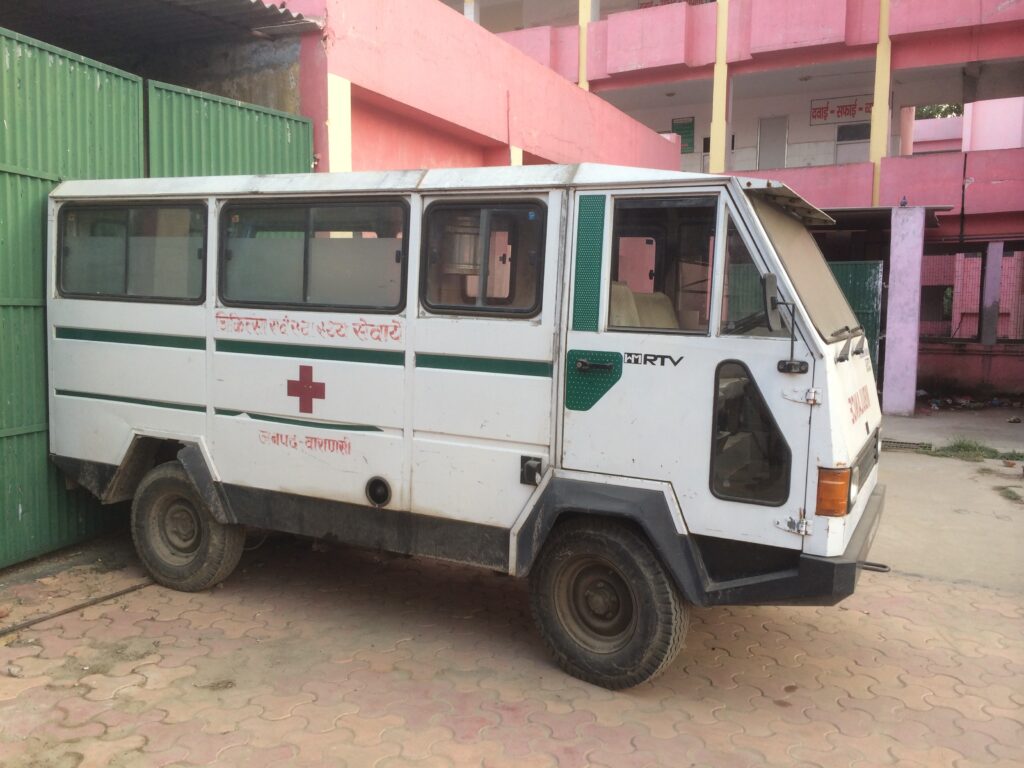
We took us some time for a short study visit at the ambulance station and, as usual, we were met by incomprehensible people who for their life couldn´t understand why we wanted to look at the cars. They were as always polite and did what they could to show and tell us about their everyday work. They had completely different conditions and things that we see as big problems at home may not be that big when you get some perspective…
Unfortunately, I didn’t get much information about what training they had and how their organization worked, but I’m convinced they’re doing a better job than I could if I was in their clothes.
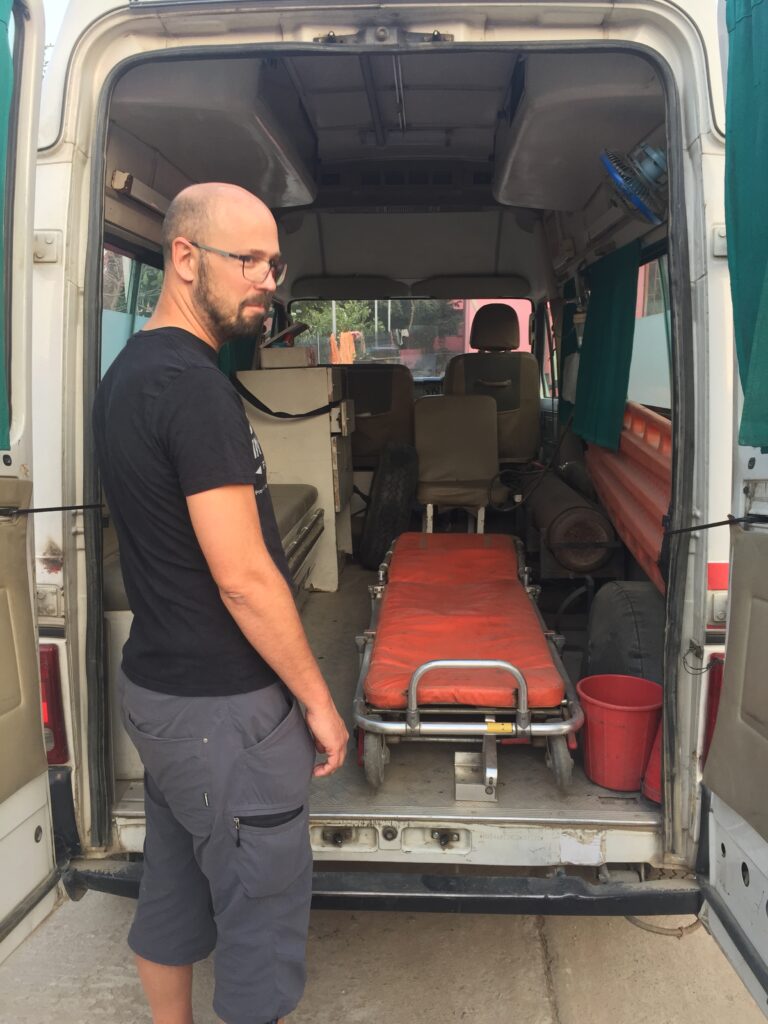
Taking The Train
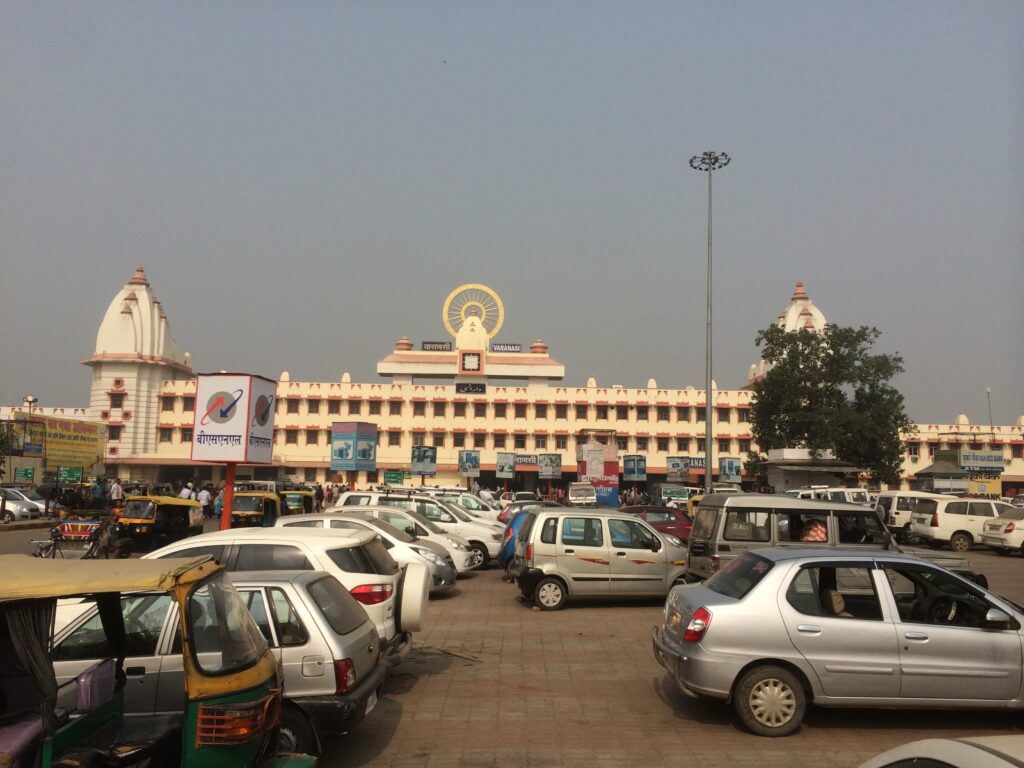
As typical Swedish travelers, we already had booked all the train tickets before we left. Booking tickets over the internet may seem like a simple thing but even though I don’t see myself as a computer illiterate, ”simple” isn’t the word I would use… It ended up with me getting an American Express card, because, in addition to a number of domestic debit cards, it was the only one accepted. In hindsight, it would probably have been easier to book/buy the tickets on site, but if you want to be reasonably sure to get to the right place at the reasonably right time, it´s nice to have the tickets in advance.
Travelling by train in India was an experience that was both fun, exciting and challenging. The crowds with passengers and cows waiting for trains was manageable but we didn´t understand the traffic information system. There were certainly both train numbers and numbers on the platforms, but when we accidently looked at the passenger lists (A4 sheets hung on each carriage) on a completely different train from the one we thought we were waiting for and found our names on the list, we understood that the information on the information boards probably was more of a guesswork, possibly advice, than actual information. Apart from the fact that I started to get symptoms of Dehli-Belly, it was really convenient to travel by train (1st class). Not great with bad belly on a train, but with a little help from a friend (antibiotics) it was survivable.
Next stop Taj Mahal!
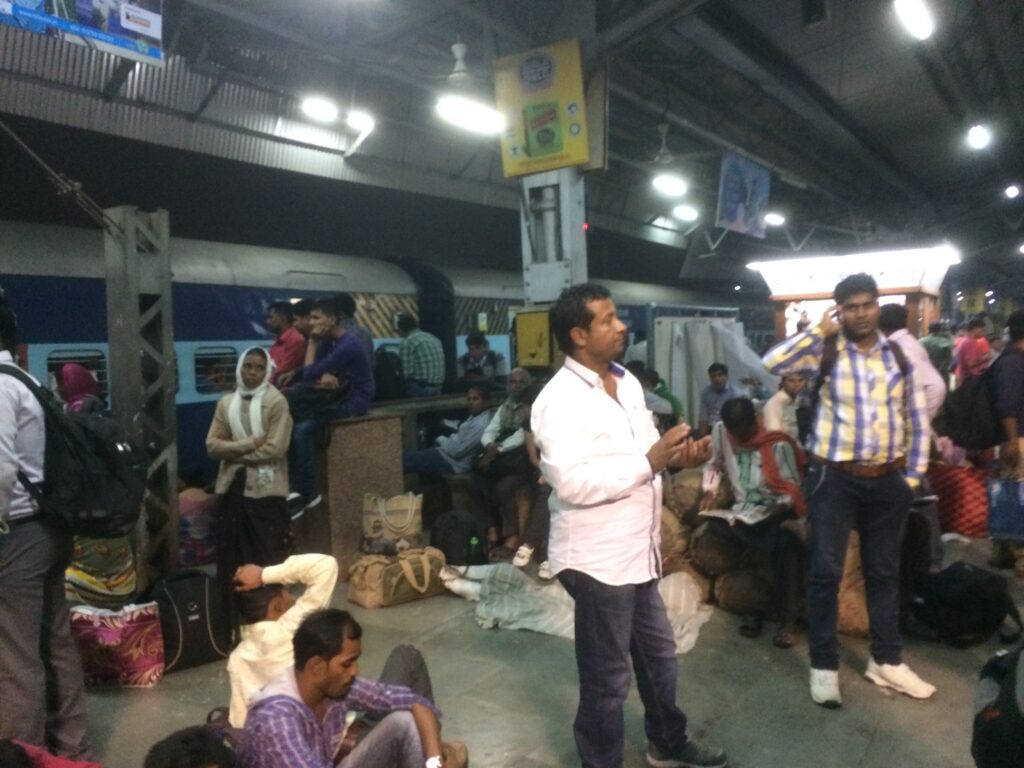
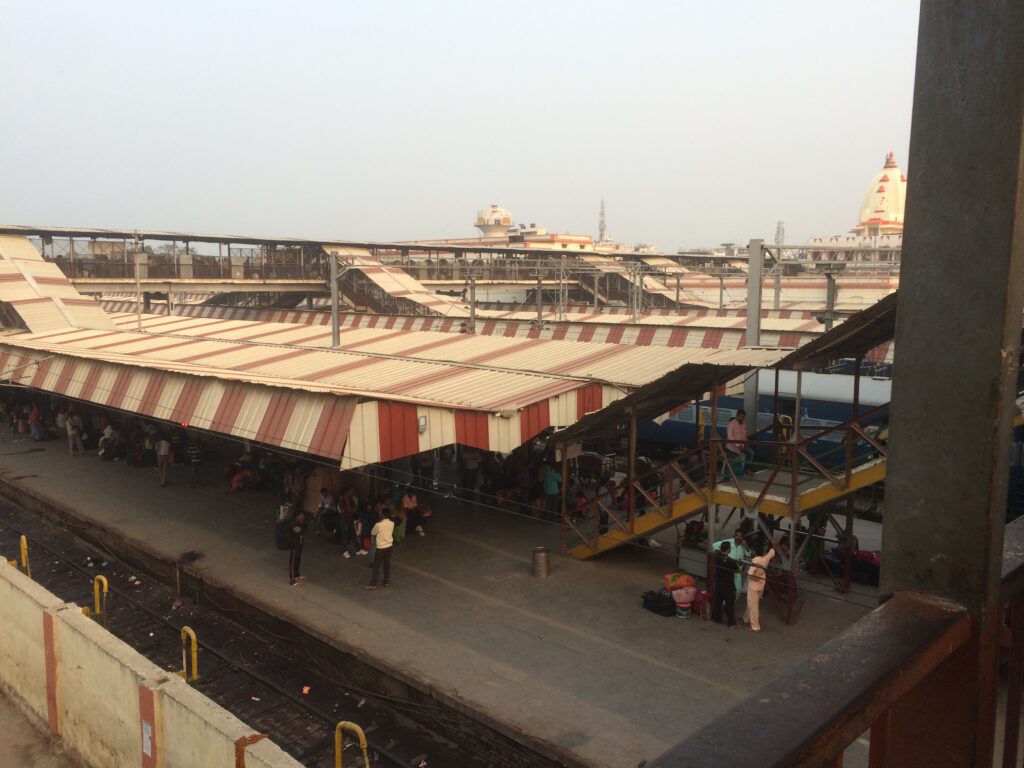
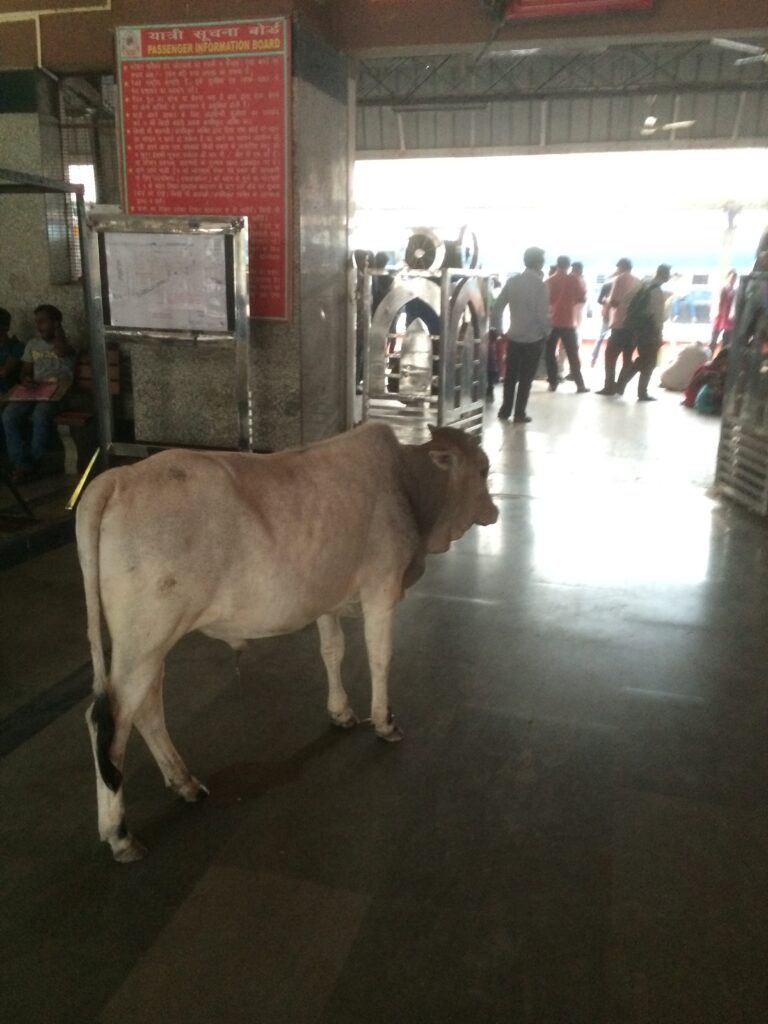
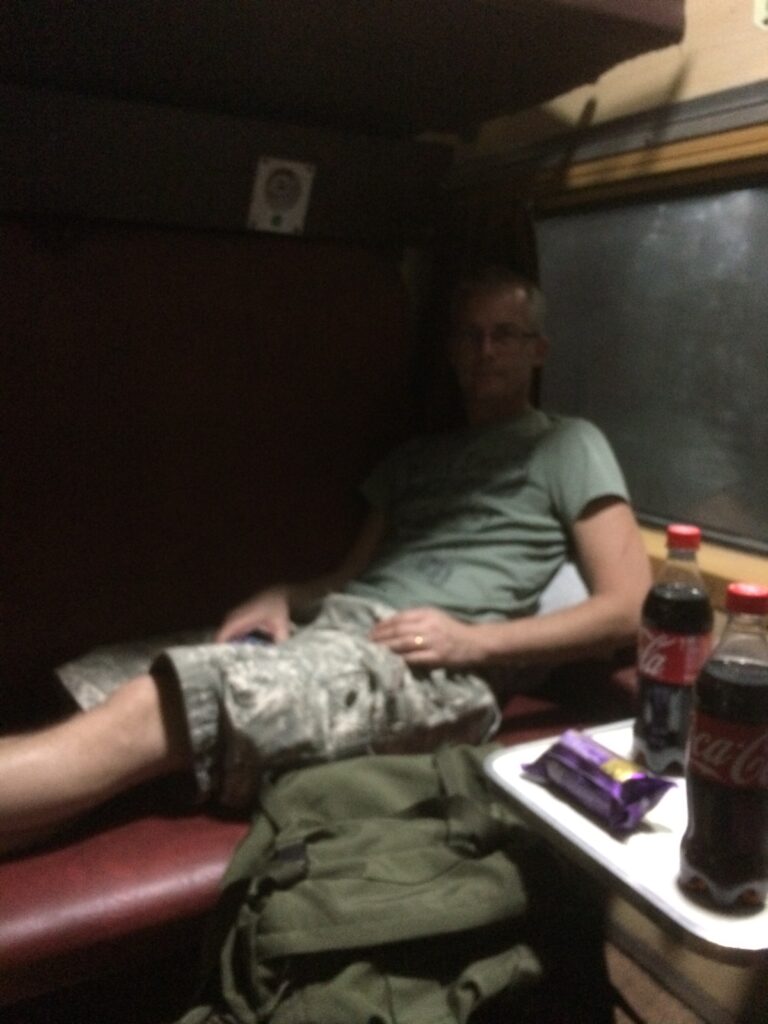
Fabulous Taj Mahal
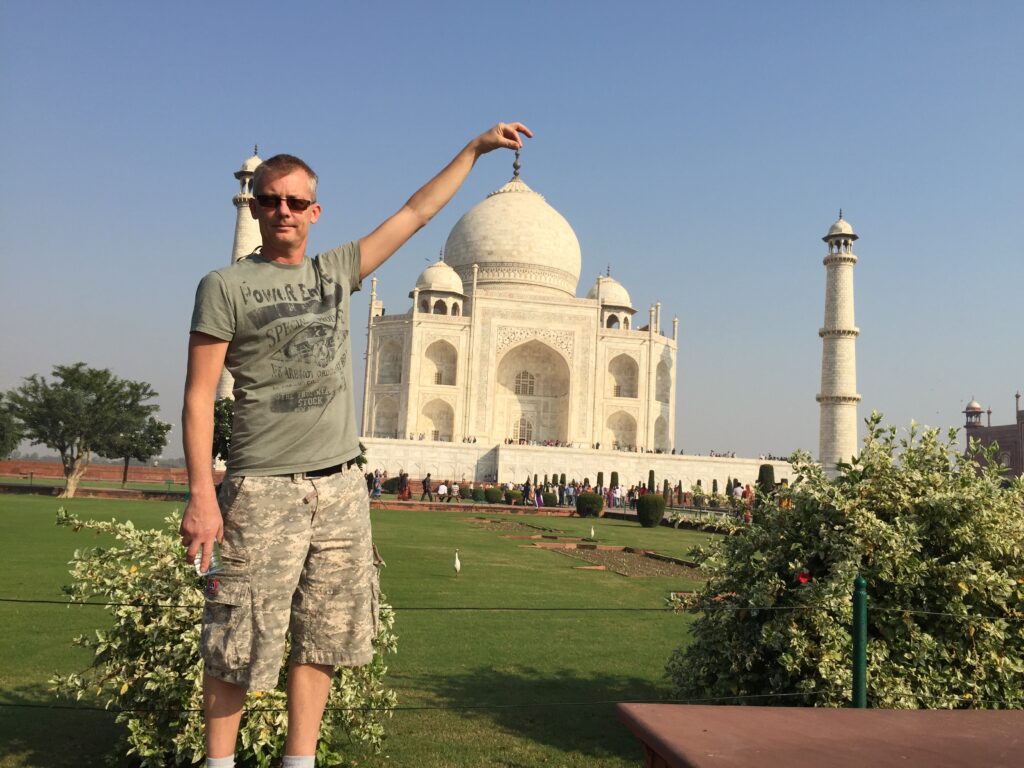
We have been to many unique and completely indescribably cool places in the world and although it is difficult to compare different sights with each other, the Taj Mahal was one of a kind! Apart from the symptoms from my Delhi Belly, it was warm, dusty and far too many tourists but still so insane awesome! Worth every second!
When the emperor Shah Jahan lost his wife in 1631, he hired about 20,000 builders and artists to build the mausoleum in 10 to 20 years. Unfortunately, at the same time, he lost focus on the rule of the empire and he probably spent ”a little” too much of the empire’s treasury on his construction. His son ended up deposing him and putting him in custody at the Red Fort, which is a few miles from the Taj Mahal. Whether it was good or bad that he had a view of the Taj Mahal from there the history doesn’t tell…
UNESCO writes on their website about World Heritage Sites:
”Taj Mahal represents the finest architectural and artistic achievement through perfect harmony and excellent craftsmanship in a whole range of Indo-Islamic sepulchral architecture. It is a masterpiece of architectural style in conception, treatment and execution and has unique aesthetic qualities in balance, symmetry and harmonious blending of various elements.”
And now I have nothing more to say about that😊
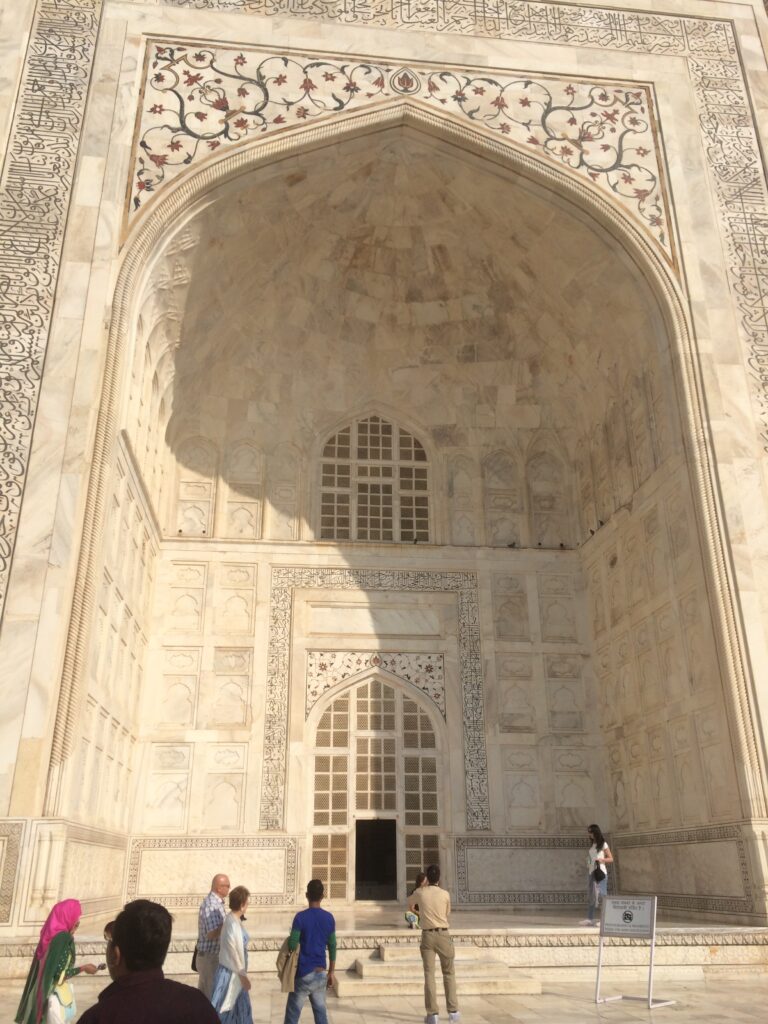
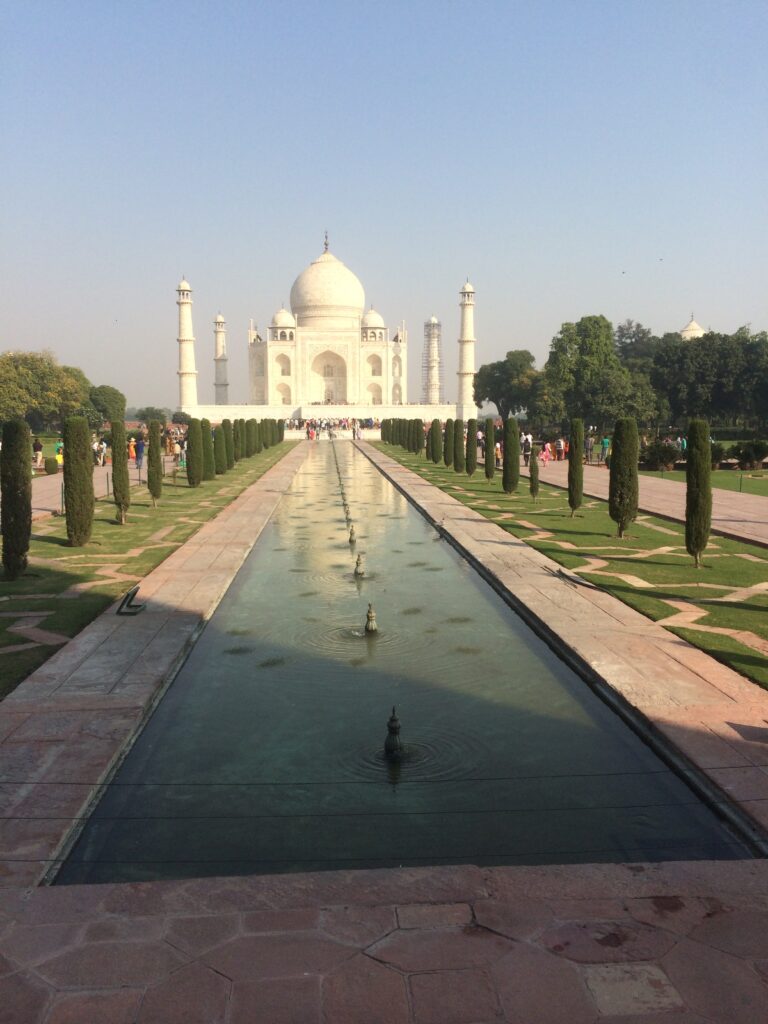
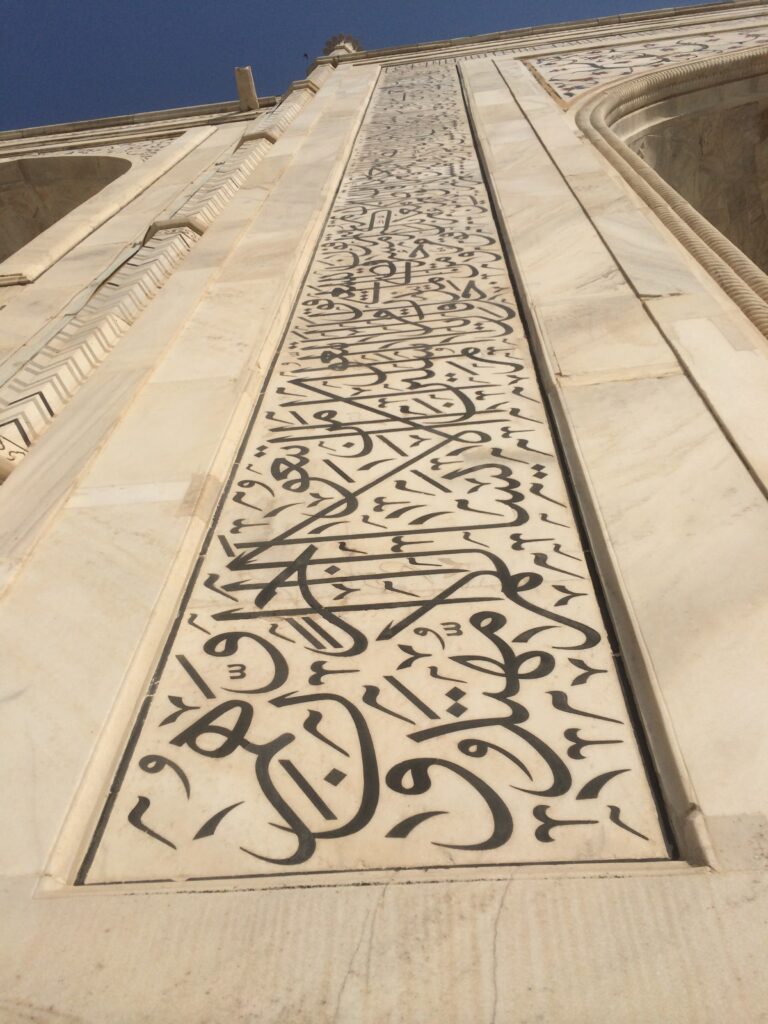

Across the river, Shah Jahan planned to build a black Taj Mahal! If it had become a reality, the combined Taj Mahal´s probably would have been on the list of the seven miracles in the world instead of the seven wonders.
Unfortunately, it turned out that the guide’s story of a black Taj Mahal was just a myth…
Agra
We were only one day in Agra, so we’re not exactly qualified to write a Lonely Planet review. Aside from the Taj Mahal and Red Fort, the city didn’t seem to have much more to offer. But if you have the Taj Mahal, you don’t need much more:)
OK, Itmad-Ud-Daulah’s tomb, also called Baby Taj was absolutely worth seeing and in any other city it had been the main course but here it was just a stop on the way. The tomb monument was built before the Taj Mahal (between 1622 and 1628) and is often seen as a model for the Taj Mahal.
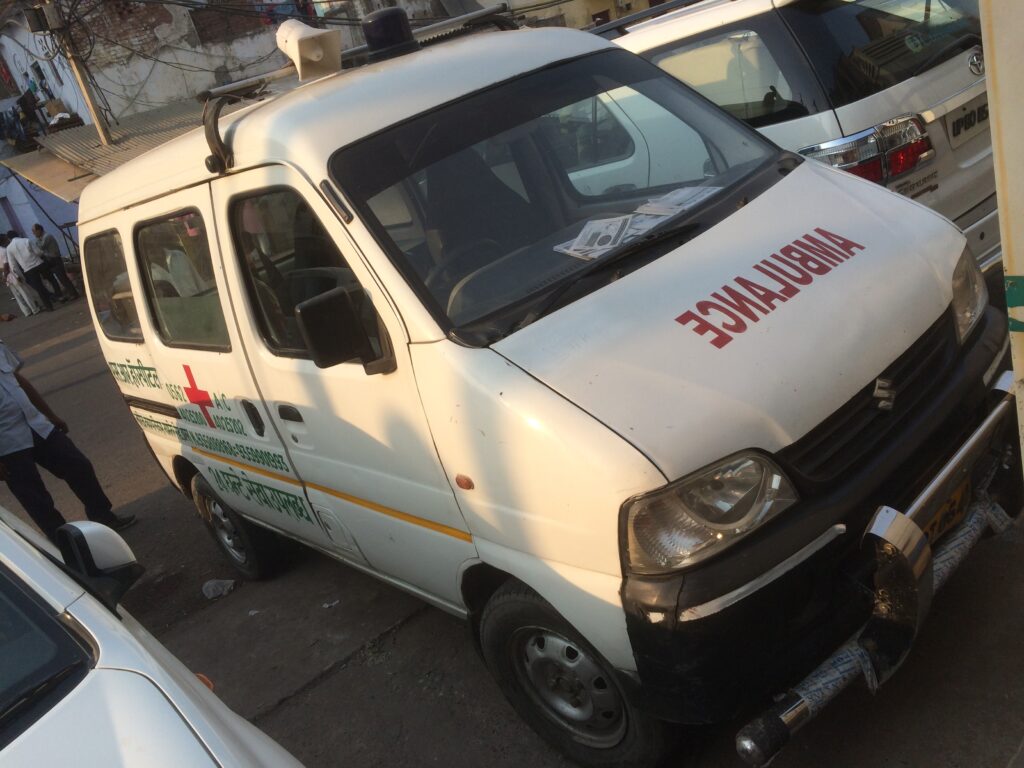

The Red Fort in Agra was built in the mid-12th century and rebuilt during the time of Akbar the Great from 1558 to 1573. During Akbar’s time as India’s emperor, Agra also served as his capital. This is where Shah Jahan was imprisoned after he completed the construction of the Taj Mahal.
When I was younger and read about old castles and forts in various adventure novels, this is what I imagined a really big fort would look like. Massive and really impressive building that looked completely unattackable!
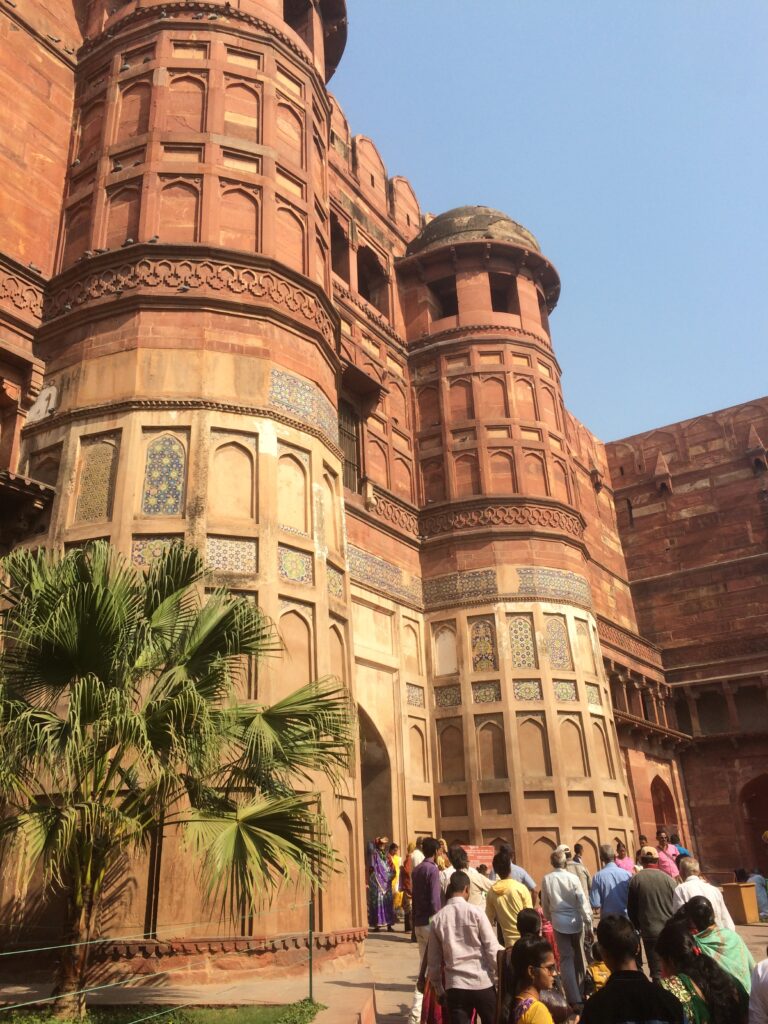
Delhi
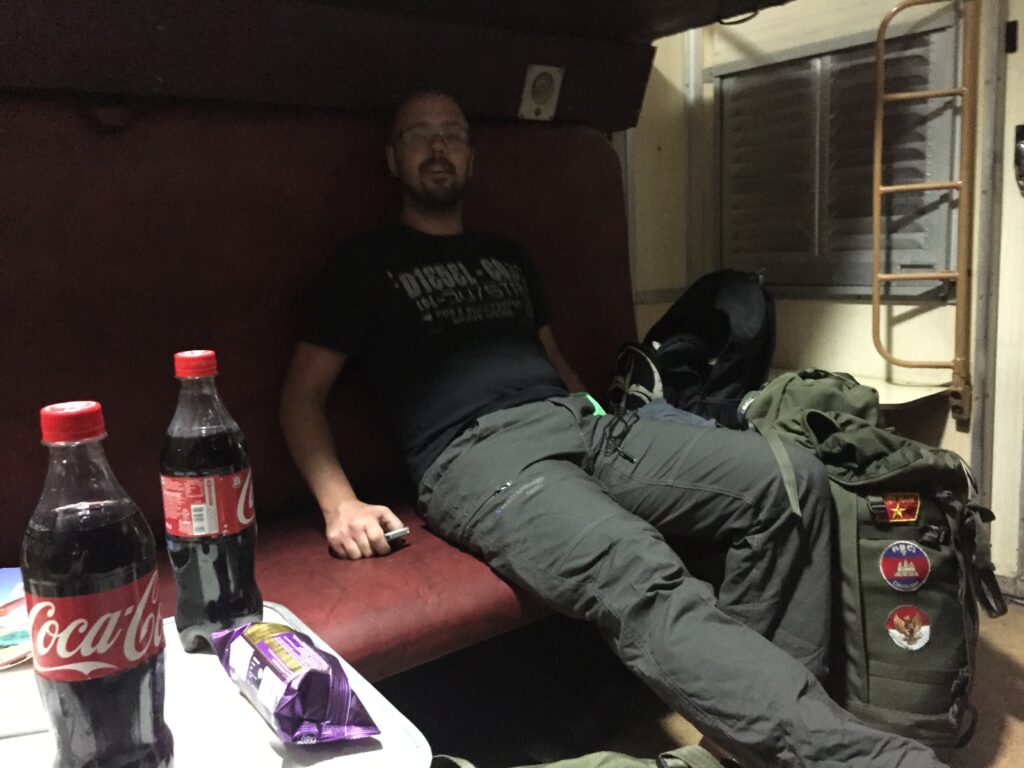
After a full day in Agra, it was quite nice to get on the train towards Delhi. Along the way, we learned how to clean all the train coupes in a train carriage in less than 5 minutes… Open the door, reach in your arm and spray with an unknown, sharply smelling agent for about 30 seconds and say ”Thank you”. Then it’s done:)
Like India as a whole, it was hard to capture Delhi’s soul. Could hardly tell if you hated or loved the city. On the negative side, it was mainly air quality and traffic that were the major problems, but at the same time there was so much to see and do. Just walking on Delhi’s ”spice street” with all the commerce and exciting smells was a memory for life. However, it was almost impossible to get a beer, at least in what we perceived to be Old Delhi and with that warmth and all the dust it felt like a quest for an oasis in the Sahara…
The pub and restaurant culture are not as they usually are in major cities so it wasn´t until we arrived in Delhi’s more central parts that we finally found a bar. But then it tasted as the probably best beer in the world:)
Despite the short stay in Delhi, we had time to visit the Red Fort. The Red Fort was an impressive building where only the wall was more than 2.5 km long. Apparently, the construction was initiated by the same emperor (Shah Jahan) who had built the Taj Mahal.



At the train station in Delhi, we handed out Janne’s last teddy bear😊

In Sweden, we are used to a heavily regulated alcohol market with special shops selling alcoholic beverages in a very orderly manner. Liquor store type ”hole-in-the-wall” with a nonexistent queue system required a lot of sharp elbows. But in the end, I got my Indian whiskey, and with that we’ll end this trip.
Two weeks is not enough for understanding a country as diverse and large as India. We’ll probably have to come here again:)
Bye bye India!